Finches are a family of small-bodied birds that are widely distributed throughout the world. They are often recognizable by their bright colors, small size, and melodious singing.
Finches have adapted to a variety of habitats, from urban gardens to dense forests, and have been popular among birdwatchers for centuries. There are more than 150 species of finches, including some that are threatened, endangered, or even extinct in the wild.
This article will provide an overview of the different finch species, their characteristics, and their habitats.
1. House Finch

The House Finch is a species of finch native to western North America and has been introduced in the eastern half of the continent as well as Hawaii.
It’s an average-sized finch with adults measuring 12.5 – 15 cm (5 – 6 inches) long and having wingspans between 20 – 25 cm (8 – 10 inches).
The upperparts are brown, while its underparts range from pale grayish white to yellow depending on subspecies.
Its face is streaked or spotted with reddish coloration; males typically have brighter plumage than females due to sexual dimorphism.
They’re mostly found near human habitations such as farms and gardens where they feed on grains, fruits, insects etc., making them very popular among birders who want something colorful for their backyard.Scientific classification:
| Kingdom | Animalia |
| Phylum | Chordata |
| Class | Aves |
| Order | Passeriformes |
| Family | Fringillidae |
| Subfamily | Carduelinae |
| Genus | Haemorhous |
| Species | H. mexicanus |
2. American Goldfinch
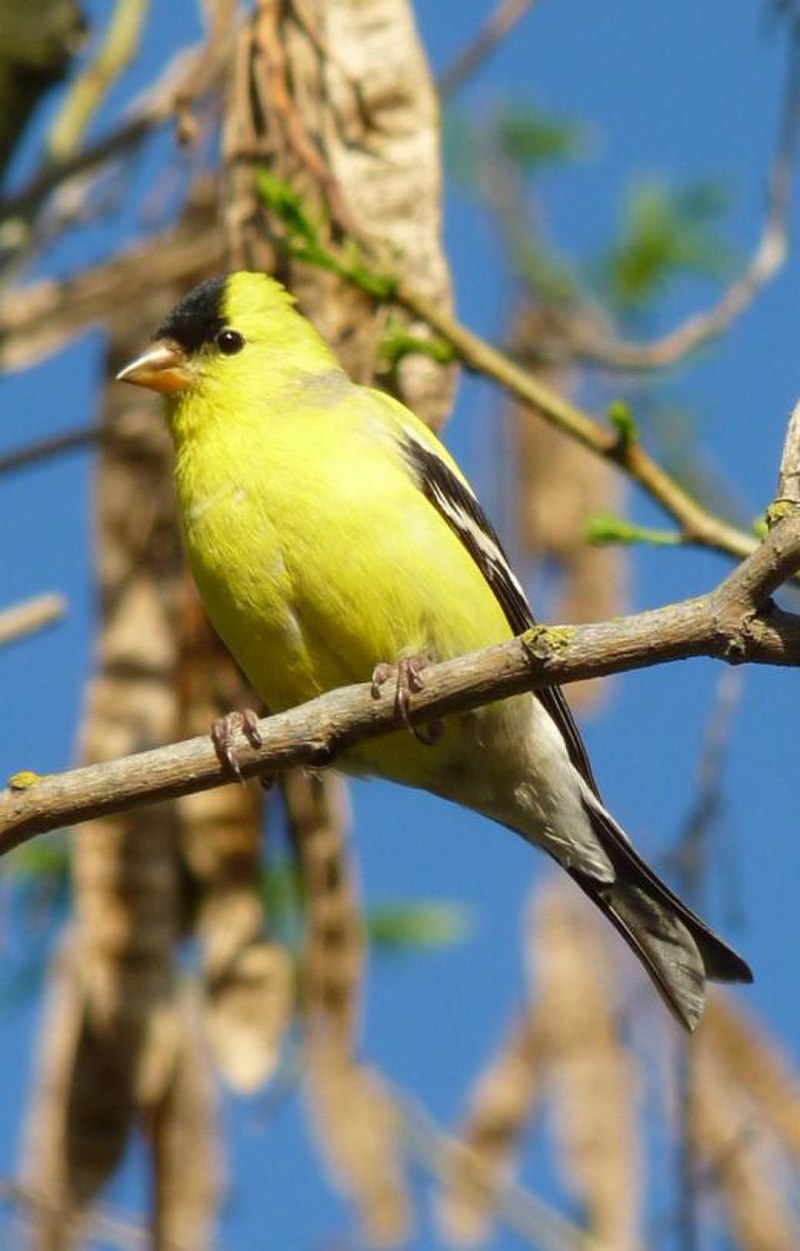
The American goldfinch is a small North American bird in the finch family. Males are vibrant yellow with black wings and tail, while females are duller in colouration.
It migrates from mid-Alberta to North Carolina during breeding season, south of Canada–United States border to Mexico for its wintering grounds.
The only finch which undergoes complete molt every year, it displays sexual dichromatism where males have brighter colours than their female counterparts.
They feed mainly on seeds but also eat insects such as aphids and caterpillars when raising youngs; they often occur near thistles or other plants that produce viable seed heads.
Their call consists of an array of chirps and trills making them quite conspicuous.Scientific classification:
| Kingdom | Animalia |
| Phylum | Chordata |
| Class | Aves |
| Order | Passeriformes |
| Family | Fringillidae |
| Subfamily | Carduelinae |
| Genus | Spinus |
| Species | S. tristis |
3. Purple Finch

The Purple Finch is a species of finch from North America, belonging to the Fringillidae family.
It’s also known as an “American Rosefinch” due to its resemblance in color and size to some European rosefinches.
Their plumage ranges from pinkish-purple on their heads and wings, with a light brown underside.
They are small birds that measure about 5-6 inches long with short thin beaks for eating seeds and insects.
In addition, they have thick round bodies which help them stay warm during cold winters in the northern parts of their range.
The Purple Finch has adapted well over time making it easier for them to survive even though there are increasing threats posed by humans such as deforestation or habitat destruction caused by development projects near their habitats.Scientific classification:
| Kingdom | Animalia |
| Phylum | Chordata |
| Class | Aves |
| Order | Passeriformes |
| Family | Fringillidae |
| Subfamily | Carduelinae |
| Genus | Haemorhous |
| Species | H. purpureus |
4. Common Redpoll
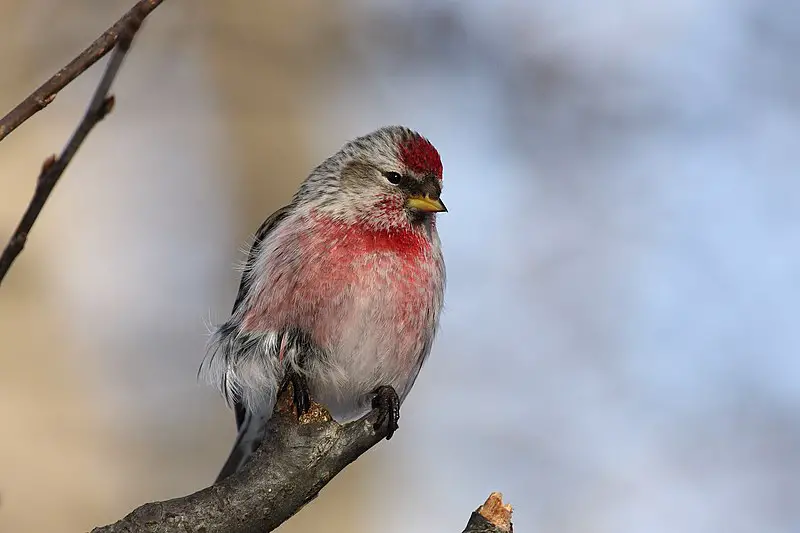
The Common Redpoll is a species of bird belonging to the finch family. It has an orange-red crown, white breast and grey back with two black stripes running down either side.
Its wings are barred in browns and its tail feathers have a grayish tinge at their tips. The redpoll breeds mainly south from Arctic regions in habitats that contain shrubs or thickets.
First classified by Linnaeus in 1758 under the binomial name Fringilla flammea, it’s genus Acanthis originates from Ancient Greek akantha meaning “thorn” or “prickle”.
This small yet colourful bird feeds mainly on seeds such as thistles during summer months but switches over to birch catkins when winter arrives – making them a common sight throughout much of North America and Eurasia.Scientific classification:
| Kingdom | Animalia |
| Phylum | Chordata |
| Class | Aves |
| Order | Passeriformes |
| Family | Fringillidae |
| Subfamily | Carduelinae |
| Genus | Acanthis |
| Species | A. flammea |
Also Featured In: Most Common Winter Birds, New Hampshire Birds You Should Know
5. European Goldfinch
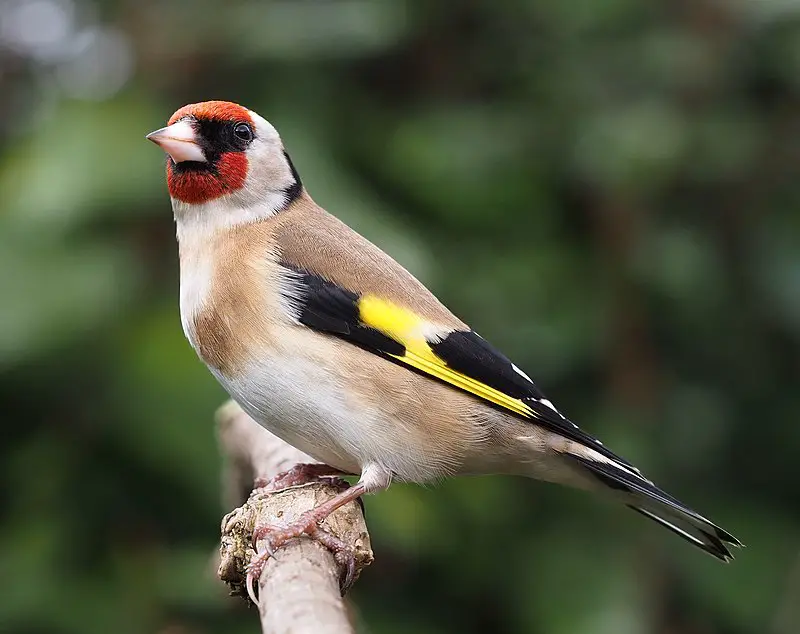
The European Goldfinch is a small passerine bird belonging to the finch family. It inhabits Europe, North Africa, western and central Asia but has been introduced in other places such as Australia, New Zealand and Uruguay.
The breeding male of this species can be easily identified by its red face with black markings around the eyes and black-and-white head.
Its back and flanks are buff or yellowish in color while it has white underparts which contrast well with its dark wings edged in white feathers.
This bird feeds on grains from plants like millet or sunflower seeds along with insects occasionally when available during summer months for food source.
In winter they flock together near sources of water where they find their food among weeds growing there at that time of year.Scientific classification:
| Kingdom | Animalia |
| Phylum | Chordata |
| Class | Aves |
| Order | Passeriformes |
| Family | Fringillidae |
| Subfamily | Carduelinae |
| Genus | Carduelis |
| Species | C. carduelis |
6. Medium Ground Finch
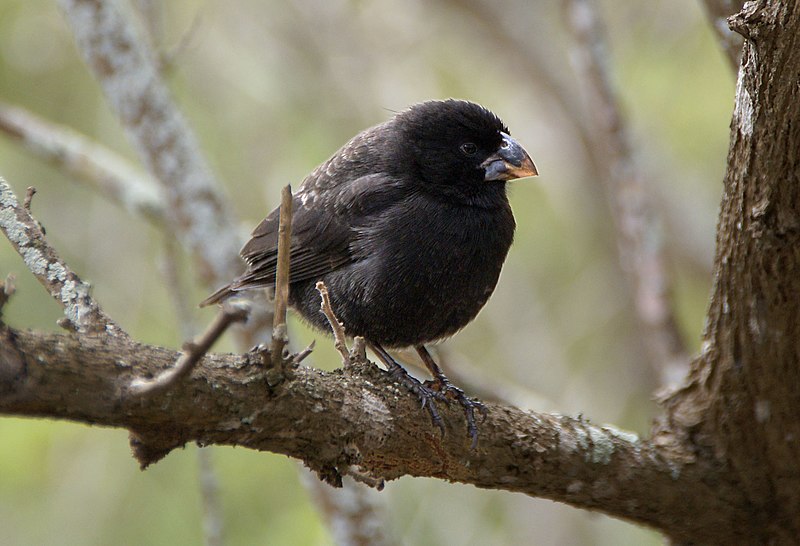
The medium ground finch (Geospiza fortis) is a species of bird found only in the Galapagos Islands. It inhabits tropical shrubland and is one of Charles Darwin’s famous “finches”.
Scientists have observed this birds evolution occurring over time, making it an important study subject.
Unfortunately, due to its small population size, the medium ground finch has been suffering from inbreeding depression for some time now.
This means that many individuals are unable to breed successfully or produce healthy offspring as a result of their lack of genetic diversity.
Conservation efforts must be taken in order to ensure that these amazing creatures do not go extinct.Scientific classification:
| Kingdom | Animalia |
| Phylum | Chordata |
| Class | Aves |
| Order | Passeriformes |
| Family | Thraupidae |
| Genus | Geospiza |
| Species | G. fortis |
Also Featured In: Galapagos Birds You Should Know, Birds of Galápagos Islands You Need to Know
7. Red Crossbill
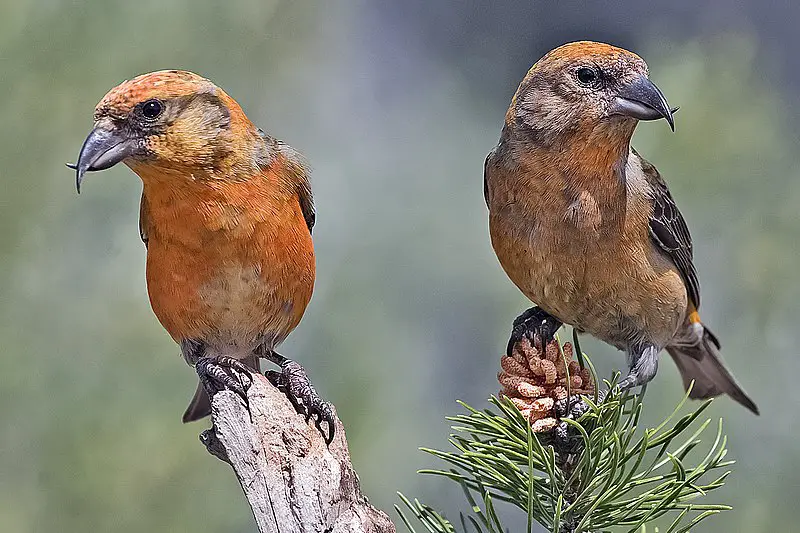
The Red Crossbill is a small passerine bird belonging to the finch family. It has distinctively crossed mandibles, which it uses to extract seeds from conifer cones and other fruits.
This species can be identified by its vivid colouring; males are red or orange in hue whilst females tend to have more green or yellow feathers.
Furthermore, there is considerable variation between individuals of this species when it comes to their beaks size and shape as well as their calls—which range from short trills through chirps and harsh cackles up until loud rattling sounds at times.
They’re an interesting sight in many parts of Europe, particularly during winter months where they often feed on pine cone seeds that drop down onto lower branches of trees.Scientific classification:
| Kingdom | Animalia |
| Phylum | Chordata |
| Class | Aves |
| Order | Passeriformes |
| Family | Fringillidae |
| Subfamily | Carduelinae |
| Genus | Loxia |
| Species | L. curvirostra |
Also Featured In: Common Birds in Saskatchewan, Common Birds in Alberta
8. Pine Siskin
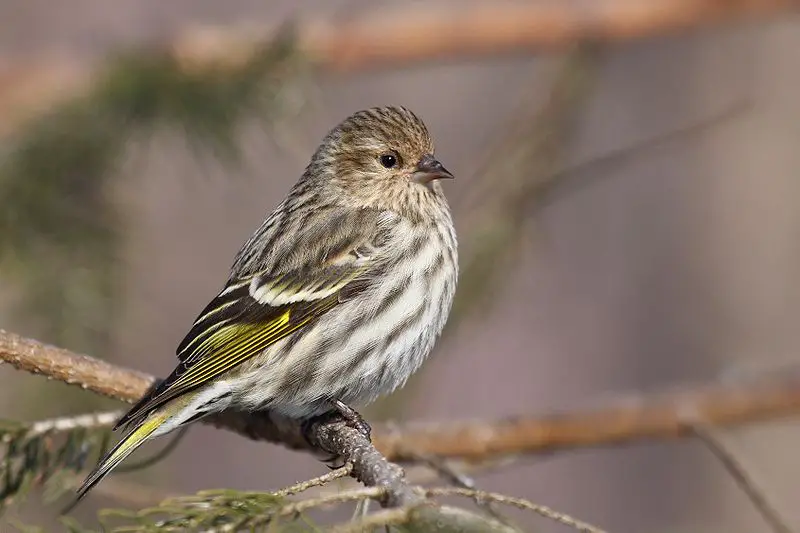
The Pine Siskin is a small bird from the finch family, primarily found in North America. It has an irregular migratory range and was first described by American ornithologist Alexander Wilson in 1810.
The species gets its name pinus, which means “pine-tree” in Latin, due to its frequent presence near coniferous trees.
Pine siskins are known for their yellow wing bars and streaked chests as well as their perky mannerisms when perched on branches or flying around looking for food during colder months.
They feed mostly on seeds of weeds, grasses and other plants but can also be seen consuming insects at times during summertime nesting season.
Its loud calls often alert nearby birds of potential danger while they nest high up among pine tree limbs where predators cannot reach them easily.Scientific classification:
| Kingdom | Animalia |
| Phylum | Chordata |
| Class | Aves |
| Order | Passeriformes |
| Family | Fringillidae |
| Subfamily | Carduelinae |
| Genus | Spinus |
| Species | S. pinus |
Also Featured In: Autumn Birds You Should Know, Birds that Live in Mississippi
9. Cassin’s Finch
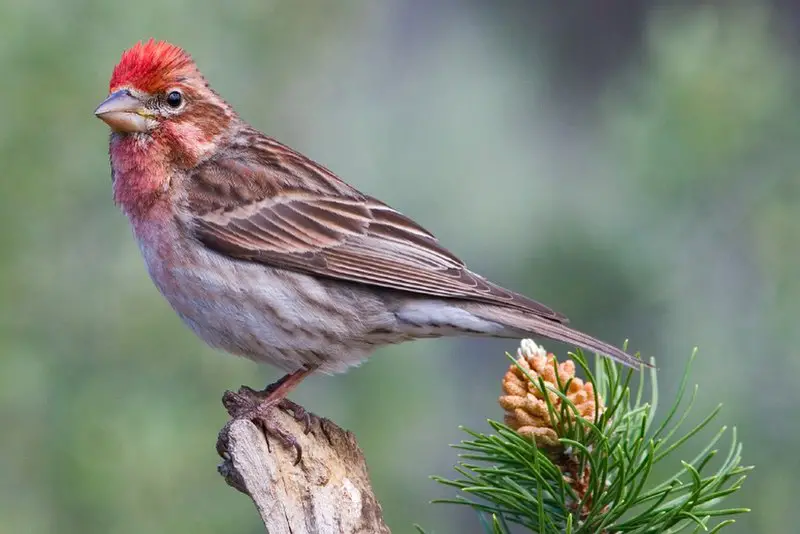
Cassin’s finch is a species of bird belonging to the Fringillidae family. It has brown wings and tail, with a longer bill than that of the purple finch.
Adult males are raspberry red on their head, breast, back and rump with streaked backs and undertail feathers.
The adult female Cassin’s Finch is duller in colouration than male but still shows pinkish tones around its face and neck area as well as subtle streaks across its body.
This species can be found mainly in western North America from Alaska down to California where they inhabit coniferous forests along mountain slopes or near riversides at elevations between 500-3000 meters above sea level.
They feed mainly on grasshoppers, caterpillars and other insects which they pick up while foraging through vegetation or by flying out onto open ground surfaces.Scientific classification:
| Kingdom | Animalia |
| Phylum | Chordata |
| Class | Aves |
| Order | Passeriformes |
| Family | Fringillidae |
| Subfamily | Carduelinae |
| Genus | Haemorhous |
| Species | H. cassinii |
Also Featured In: Red birds You’ll See in Arizona, Red Birds You’ll See in Oklahoma
10. Zebra Finch
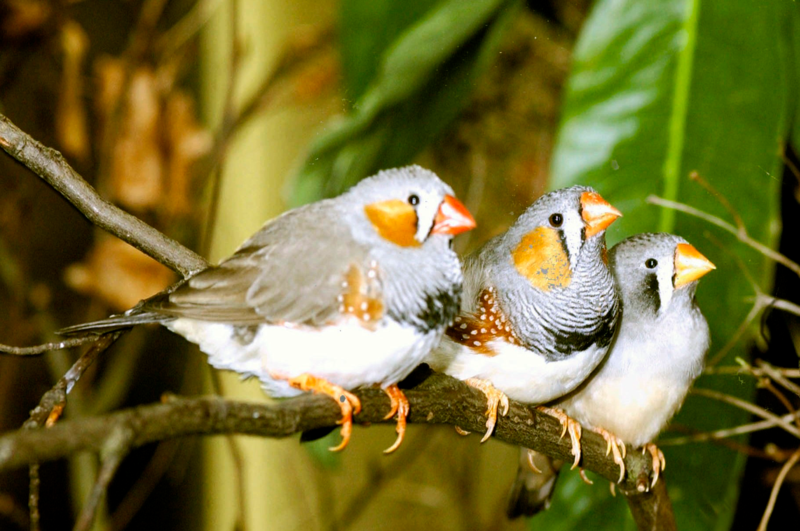
Zebra finches are two species of estrildid finch found in Australia and Indonesia. They have the ability to travel in large flocks while they feed on seeds.
The IUCN Red List and BirdLife International split them into two distinct species, the zebra finch (T. guttata) and another unnamed one, in 2016.
This recognition was later followed by the International Ornithological Congress which gave it a scientific name – Taeniopygia castanotis for this second species of zebra finches that were earlier thought to be just one single type birds until recently.
With their bright colors including black stripes across their bodies along with small song-like calls they make when flying around together, these beautiful little creatures offer quite a sight.Scientific classification:
| Kingdom | Animalia |
| Phylum | Chordata |
| Class | Aves |
| Order | Passeriformes |
| Family | Estrildidae |
| Genus | Taeniopygia Reichenbach, 1862 |
Also Featured In: Aviary Birds You Should Know, Case Birds that Live in with Us
11. Large Ground Finch
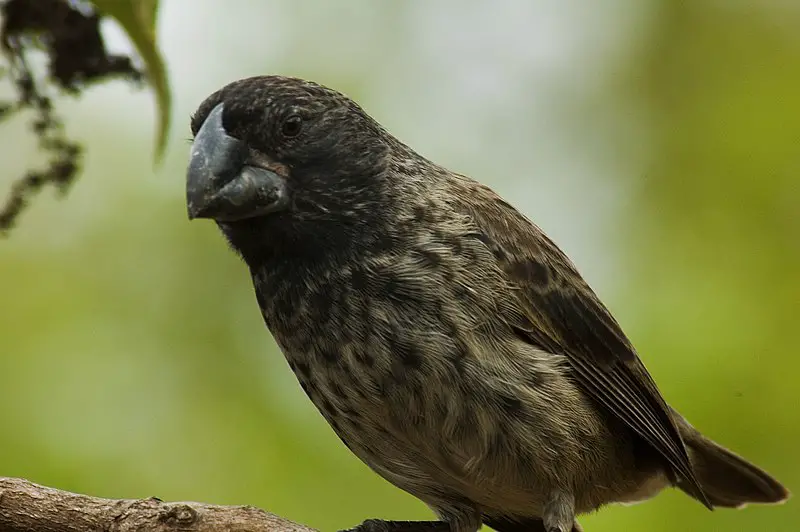
The Large Ground Finch is a species of bird from the Galapagos Islands and is part of Darwin’s Finches.
It belongs to the family Thraupidae, and its habitat ranges across most islands in the archipelago apart from Floreana, Española, San Cristobal and Santa Fe.
This finch stands out as one of the largest amongst all other species due to its large bill size relative to body mass which can reach up to 8 cm long for males.
Its diet consists mainly of seeds but it also feeds on insects during breeding season.
The conservation status for this species is listed as least concern by IUCN Red List because it has an extensive range with stable population numbers despite some fluctuations caused by droughts or food shortages.Scientific classification:
| Kingdom | Animalia |
| Phylum | Chordata |
| Class | Aves |
| Order | Passeriformes |
| Family | Thraupidae |
| Genus | Geospiza |
| Species | G. magnirostris |
Also Featured In: Birds that Charles Darwin Studied,
12. Gouldian Finch
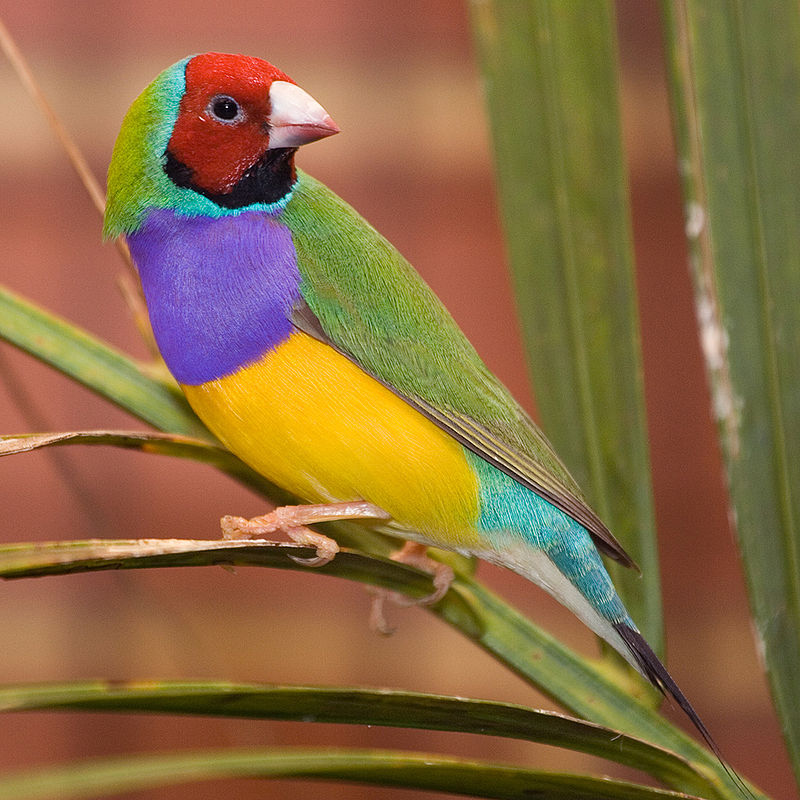
The Gouldian Finch, also known as the Lady Gouldian finch or Rainbow Finch, is a beautiful passerine bird native to Australia.
It was first described by British ornithological artist John Gould in 1844 and named after his late wife Elizabeth.
The specimens were sent to him by Benjamin Bynoe who collected them from Northern Australia.
These birds are loved for their vibrant colors which can range from yellow-green at its chest and head, purple on its wings and back with black stripes along the neckline down to some shades of blue around the tail feathers.
They feed mainly on grasses seeds but they may also eat insects when available. This species is critically endangered due mostly to habitat loss so special attention must be taken in order preserve this unique creature’s future existence.Scientific classification:
| Kingdom | Animalia |
| Phylum | Chordata |
| Class | Aves |
| Order | Passeriformes |
| Family | Estrildidae |
| Genus | Chloebia Reichenbach, 1862 |
| Species | C. gouldiae |
13. Black Rosy Finch
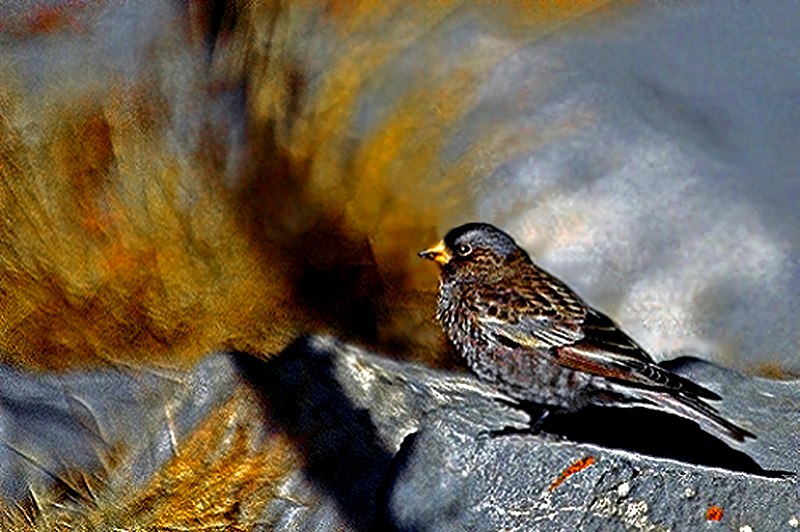
The Black Rosy Finch is a species of passerine bird in the family Fringillidae. It has an extremely limited range, primarily existing only in alpine areas above treeline in the western United States.
The first scientific description of this bird was made by American ornithologist Robert Ridgway back in 1874, and it remains popular among photographers today due to its unique beauty and rarity.
The black rosy finch’s plumage consists mainly of gray-black feathers with some carmine patches on their wings, giving them their namesake “rosy” coloring.
They have short tails and slender beaks that allow them to feed on small seeds found high up in mountain shrubs or rocksides – they are also known as nimble climbers.
Overall, these birds remain a sight to behold for anyone lucky enough to spot one while hiking through the mountainside.Scientific classification:
| Kingdom | Animalia |
| Phylum | Chordata |
| Class | Aves |
| Order | Passeriformes |
| Family | Fringillidae |
| Subfamily | Carduelinae |
| Genus | Leucosticte |
| Species | L. atrata |
Also Featured In: Red Birds that Found in the United States America,
14. Lesser Goldfinch
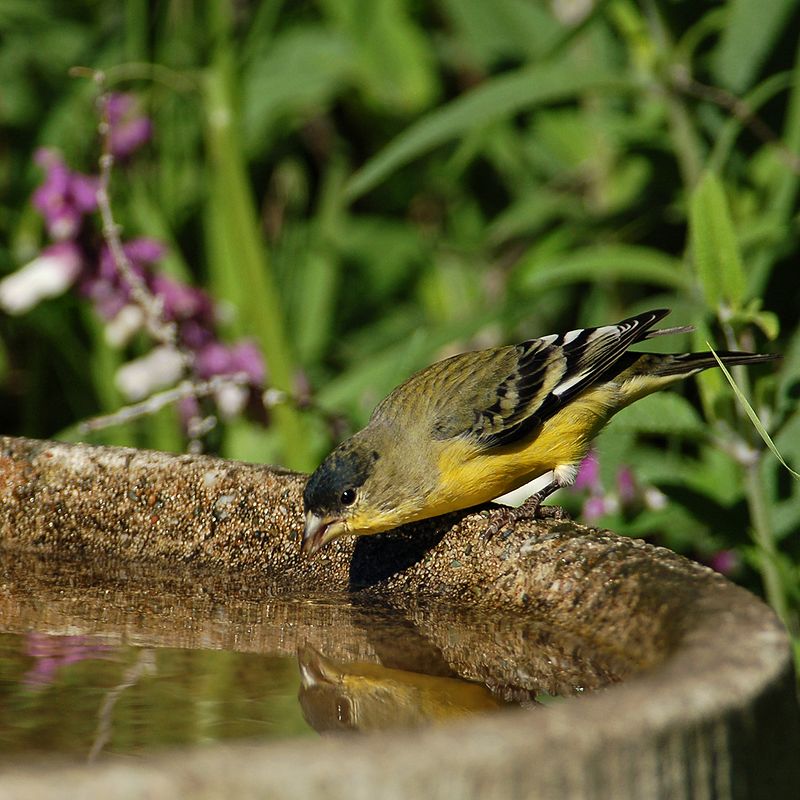
The Lesser Goldfinch is a tiny species of bird found in the Americas. It belongs to the same clade as American goldfinches and Lawrence’s goldfinches, which can be identified by their males having black or rarely green foreheads.
The face appears red or yellow on these birds unlike other species in its genus Spinus sensu stricto.
They are small songbirds with short bills, brown wings and tails with white edges, grey-brown backs and olive heads.
These birds inhabit open woodlands and fields where they feed mainly on seeds from weeds such as thistle, pigweed and ragweed but also consume insects at times during breeding season for additional nutrition.
In addition to being an important part of North America’s avian ecology, these birds have been popularized through recent artwork depicting them in various poses among flowers.Scientific classification:
| Kingdom | Animalia |
| Phylum | Chordata |
| Class | Aves |
| Order | Passeriformes |
| Family | Fringillidae |
| Subfamily | Carduelinae |
| Genus | Spinus |
| Species | S. psaltria |
15. Evening Grosbeak
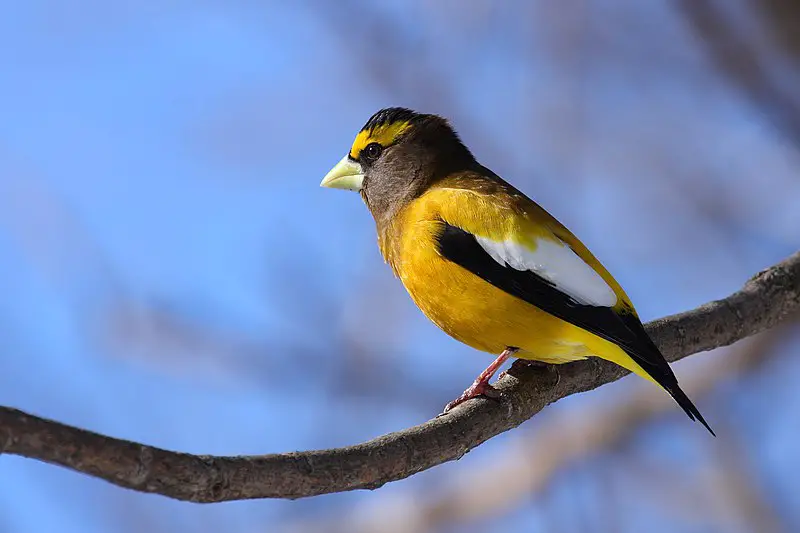
The Evening Grosbeak (Hesperiphona vespertina) is a beautiful passerine bird in the finch family Fringillidae native to North America.
It has an impressive wingspan of up to 20 inches and its plumage is mostly black, yellow or grey with distinctive white patches on each side of its head.
Its diet consists mainly of seeds and other plant matter as well as small insects, fruit and berries when available.
The male’s song is loud and melodic which can be heard from some distance away during breeding season making it a popular species for avid backyard birders.
The Evening Grosbeak typically nests high in coniferous trees where they build cup-shaped structures lined with feathers or grass that provide protection against predators.
Overall this species makes an excellent addition to any backyard aviary.Scientific classification:
| Kingdom | Animalia |
| Phylum | Chordata |
| Class | Aves |
| Order | Passeriformes |
| Family | Fringillidae |
| Subfamily | Carduelinae |
| Genus | Hesperiphona |
| Species | H. vespertina |
Also Featured In: Yellow Connecticut Birds, Common Yellow Birds of Idaho
16. Common Cactus Finch
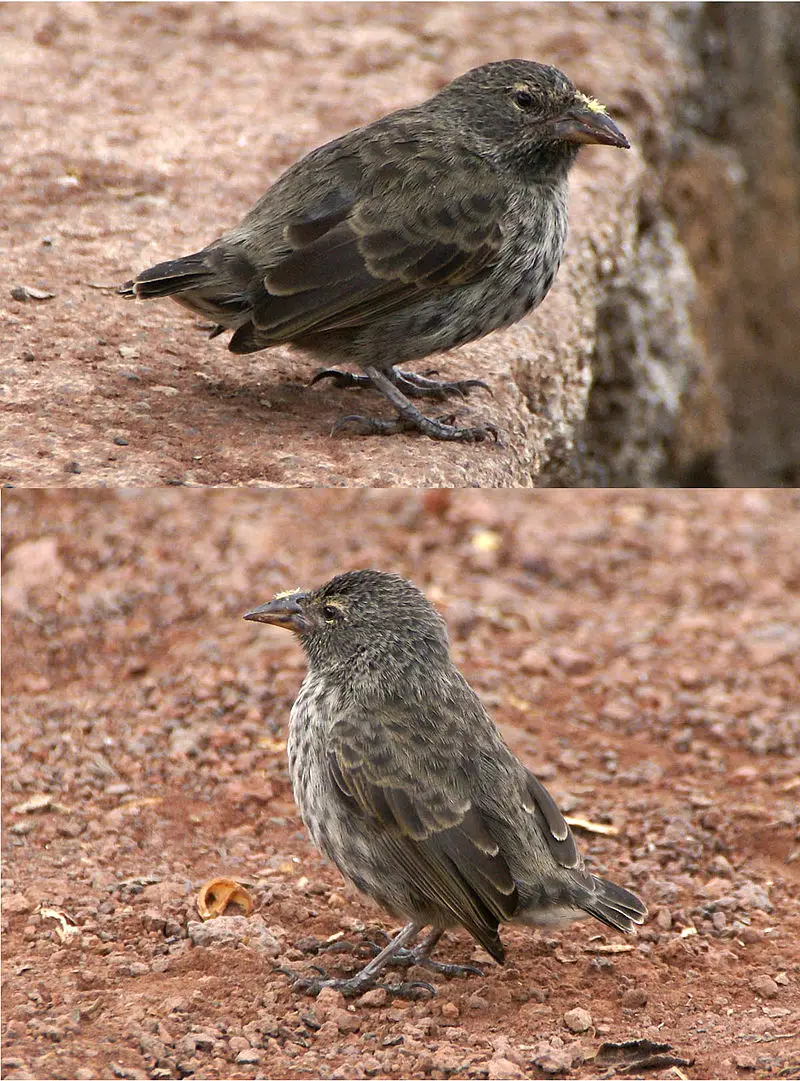
The Common Cactus Finch is a species of bird found in the Darwin’s finch group of the tanager family. It is endemic to Galapagos Islands, with exception on Fernandina, Española, Genovesa, Darwin and Wolf.
This small cacti-eating finch has an olive back and wings that are brownish grey while its chest varies from yellow to pink depending on its habitat.
They feed mainly by probing for insects in crevices or gleaning them off branches from lower trees and shrubs as well as consuming some fruits like cactus pads.
The male common cactus finches have a distinctive song which help attract females during courtship displays whereas females build nests out of twigs lined with soft grasses near ground level under bushes or low vegetation for their eggs.Scientific classification:
| Kingdom | Animalia |
| Phylum | Chordata |
| Class | Aves |
| Order | Passeriformes |
| Family | Thraupidae |
| Genus | Geospiza |
| Species | G. scandens |
17. European Greenfinch
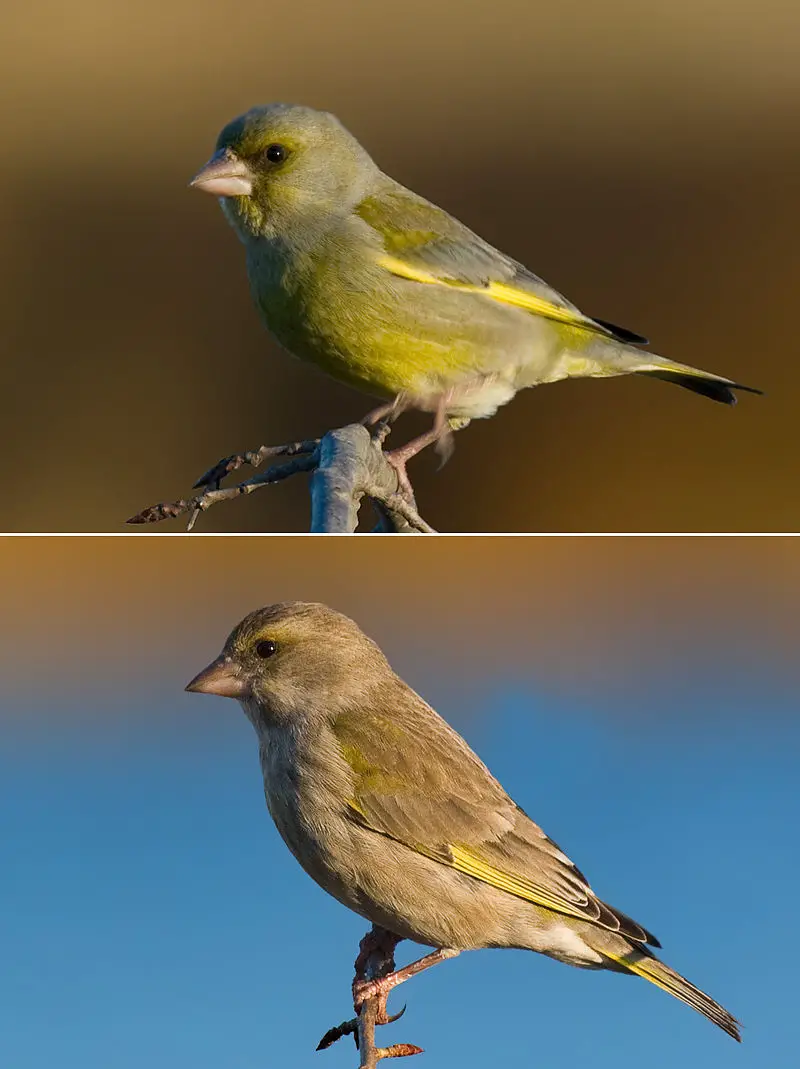
The European Greenfinch is a small, passerine bird from the finch family Fringillidae. It can be found throughout Europe, North Africa and Southwest Asia.
Some of its northernmost populations migrate further south during winter for warmer climates.
The species has been introduced to Australia, New Zealand, Uruguay and Argentina as well with great success in these new environments.
It was first described scientifically by Carl Linnaeus back in 1758 who noted its bright green feathers along with yellow edges on the wings and tail which make it an unmistakable sight when seen up close or at a distance while flying through open grasslands or wooded areas where they are known to feed on insects and seeds alike making them highly adaptable birds that find food sources easily wherever they go.Scientific classification:
| Kingdom | Animalia |
| Phylum | Chordata |
| Class | Aves |
| Order | Passeriformes |
| Family | Fringillidae |
| Subfamily | Carduelinae |
| Genus | Chloris |
| Species | C. chloris |
18. Gray-Crowned Rosy Finch
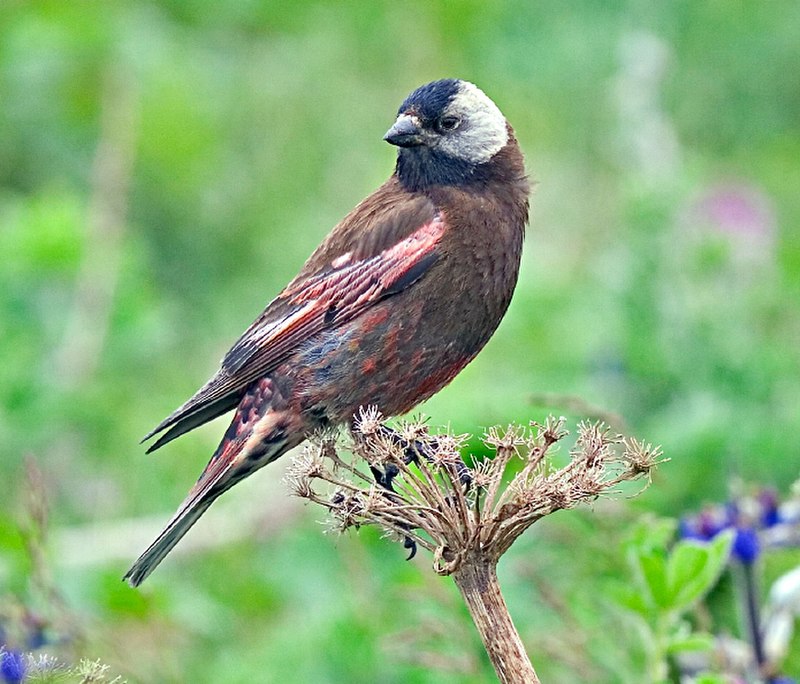
Gray-crowned rosy finches are a species of passerine bird from North America. They inhabit alpine regions, making them rarely seen in the wild and difficult to observe.
Six subspecies have been recognized and they belong to the family Fringillidae alongside three other types of Rosy Finches.
These birds have gray crowns with white throats that contrast against their black or brown heads and necks as well as their striped wings which can range from pinkish-brown to deep red depending on the location where it is observed.
The Gray-Crowned Rosy Finch has an impressive vocal repertoire composed mostly of chirps, buzzes, trills, whistles, twitters and warbles used for communication between individuals within its flock.
This bird’s diet consists mainly of vegetation such seedheads but also includes insects during breeding season when more food sources are availableScientific classification:
| Kingdom | Animalia |
| Phylum | Chordata |
| Class | Aves |
| Order | Passeriformes |
| Family | Fringillidae |
| Subfamily | Carduelinae |
| Genus | Leucosticte |
| Species | L. tephrocotis |
19. Common Chaffinch

The Common Chaffinch is a beautifully coloured small passerine bird belonging to the finch family.
The males have striking blue-grey caps and rust-red underparts, while the females are more subtle in their colouring but both possess two distinct white wing bars and white sides on their tails.
This gorgeous bird has an incredibly strong voice which can be heard for miles as it sings from exposed perches during mating season.
It lives mainly throughout Europe but also in parts of North Africa and Asia too, favouring woodland areas with plenty of shrubs or trees nearby where they find shelter amongst foliage when needed.
They feed predominantly on seeds from weeds or grains found within grasslands making them particularly useful birds for farmers who rely heavily upon pest control that these little ones provide.Scientific classification:
| Kingdom | Animalia |
| Phylum | Chordata |
| Class | Aves |
| Order | Passeriformes |
| Family | Fringillidae |
| Subfamily | Fringillinae |
| Genus | Fringilla |
| Species | F. coelebs |
20. Brown-Capped Rosy Finch
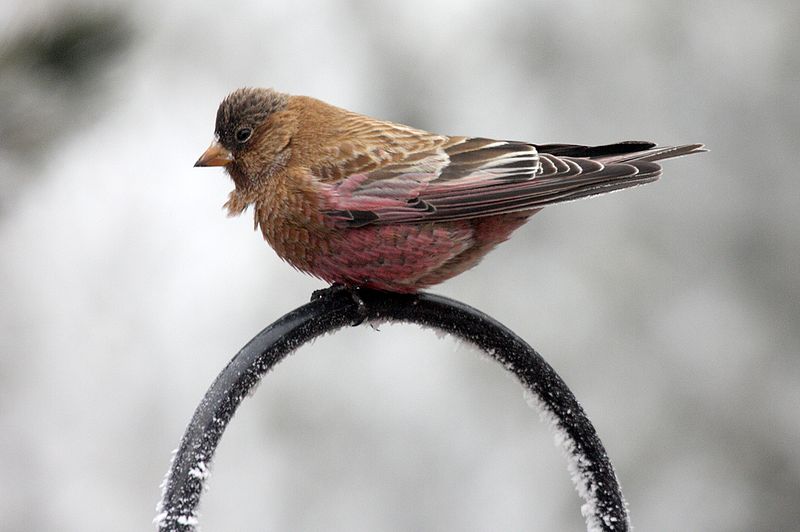
The Brown-capped Rosy Finch is a medium-sized finch native to North America. Its distinctive features include its brown head, back and breast with pink hues on the belly, rump and wings as well as a black forehead.
It also has short black legs and a long forked tail. These birds prefer mountain peaks in central Rocky Mountain areas of the United States where they build cup nests in cavities or cliffsides.
They are known to feed on grasses, grains and insects while migrating south during winter months when food resources become scarce at higher altitudes.
The Brown-capped Rosy Finch is an interesting species that adds colour among rocky landscapes.Scientific classification:
| Kingdom | Animalia |
| Phylum | Chordata |
| Class | Aves |
| Order | Passeriformes |
| Family | Fringillidae |
| Subfamily | Carduelinae |
| Genus | Leucosticte |
| Species | L. australis |
Also Featured In: Birds That Live in Colorado,
21. Eurasian Bullfinch
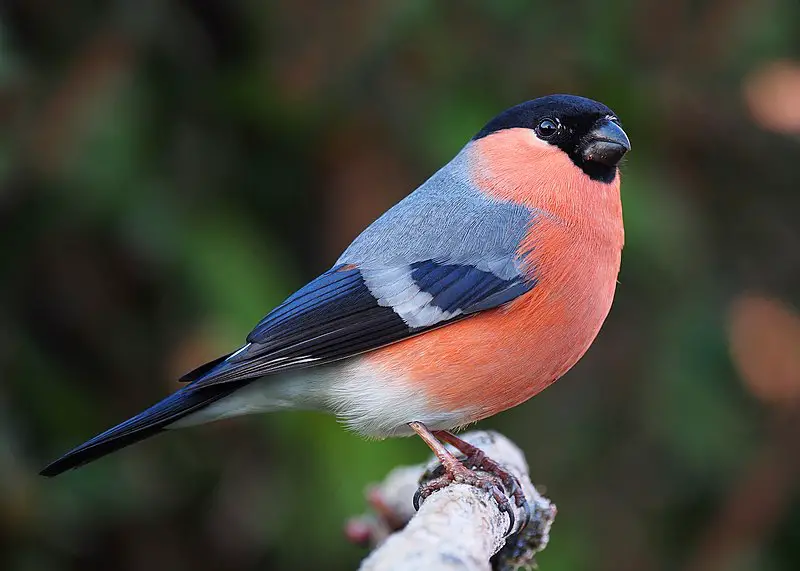
The Eurasian Bullfinch is a small bird found in the finch family, Fringillidae. It has an unmistakable appearance with its plump body and bright pink chest.
Its head is grayish-brown while its wings are black with white edging along the tips of some feathers. The tail is also black tipped with white or yellowish edges.
They inhabit open woodlands and gardens throughout Europe, North Africa, parts of Asia and western Siberia in search of food such as berries, buds or insects which they feed on during winter months when other sources become scarce.
These birds form monogamous pairs to breed each year between March through August where both parents incubate their eggs during this time until hatching around mid-May.
Usually producing two broods per season if conditions are favorable for nesting success.Scientific classification:
| Kingdom | Animalia |
| Phylum | Chordata |
| Class | Aves |
| Order | Passeriformes |
| Family | Fringillidae |
| Subfamily | Carduelinae |
| Genus | Pyrrhula |
| Species | P. pyrrhula |
22. Star Finch
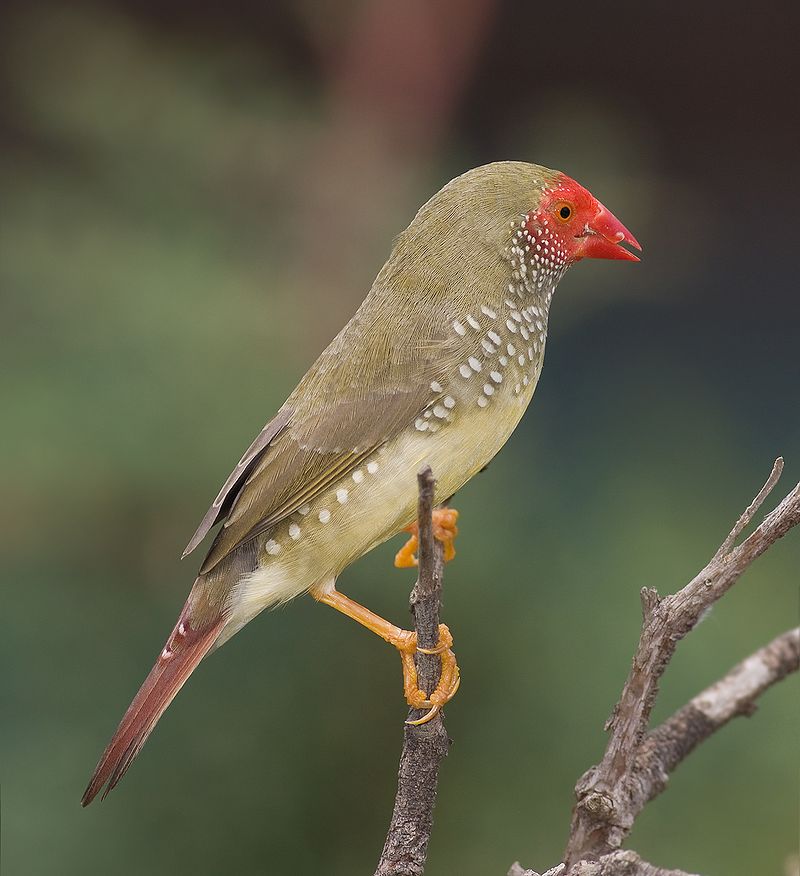
The Star Finch is a beautiful bird found in northern Australia. It has a bright red face, bill and broad white spots down its flanks which make it quite distinctive.
This species of seed-eating finch measures between 10 to 12 cm long and its upper and lower plumage are yellow-green.
One of the three subspecies may have become extinct due to loss of habitat or predation by other animals.
They usually live in open forests but can also be seen near cultivated areas where they will feed on various seeds, flowers, fruits and insects.
The Star Finch is an important part of Australian avifauna as it helps disperse seeds for regeneration purposes; making them vital for biodiversity conservation efforts in the area.Scientific classification:
| Kingdom | Animalia |
| Phylum | Chordata |
| Class | Aves |
| Order | Passeriformes |
| Family | Estrildidae |
| Genus | Bathilda Reichenbach, 1862 |
| Species | B. ruficauda |
23. Two-Barred Crossbill
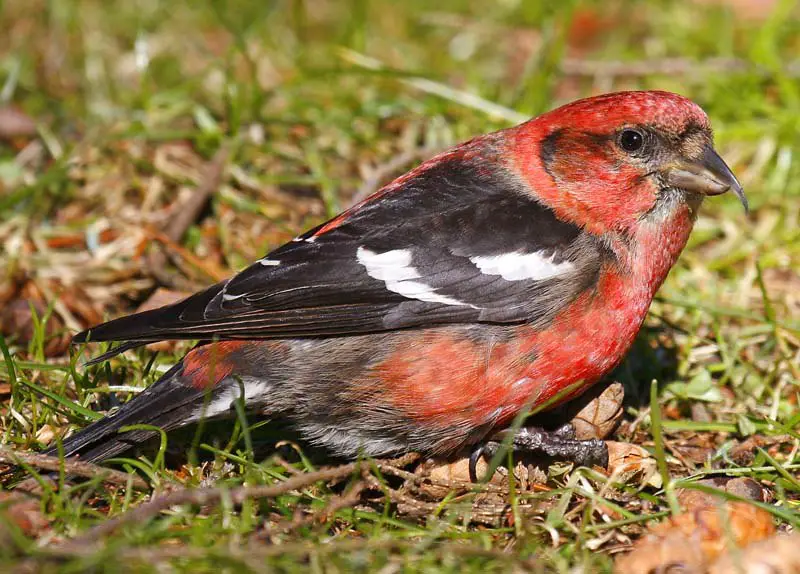
The Two-barred crossbill is a small passerine bird belonging to the finch family Fringillidae.
It gets its scientific name, Loxia leucoptera, from Ancient Greek – with ‘Loxia’ meaning ‘crosswise’ and ‘leucoptera’ translating to “white-winged” in reference to its white wings.
The species has two subspecies: the white-winged crossbill (Loxia leucoptera leucoptera) that can be found in North America and the two bar crossbill (Loxia leucocephala) which inhabits Europe, Asia as well as parts of northern Africa.
These birds feed mainly on conifer seeds but have also been seen consuming insects such as beetles or caterpillars during breeding season when food resources are scarce for their young ones.
They construct nests made out of twigs near trunks of spruce trees where they lay 2–6 eggs at one time.Scientific classification:
| Kingdom | Animalia |
| Phylum | Chordata |
| Class | Aves |
| Order | Passeriformes |
| Family | Fringillidae |
| Subfamily | Carduelinae |
| Genus | Loxia |
| Species | L. leucoptera |
Also Featured In: Birds that Migrate through Illinois in the Spring, Red Minnesota Birds You Need to Know
24. Española Cactus Finch
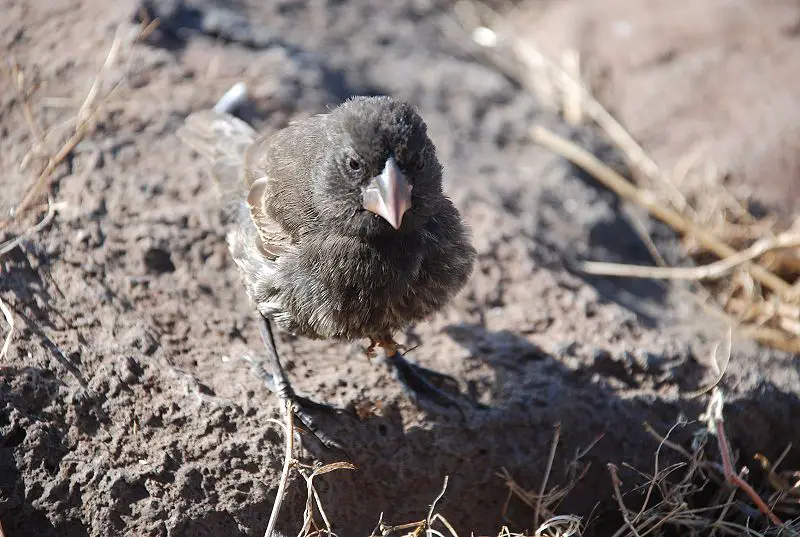
The Española cactus finch is a unique species of bird in the tanager family Thraupidae, endemic to the Galápagos islands.
It is one of Darwin’s finches and has distinctive dark feathers with a finer beak than its relative, the Common Cactus Finch.
This species can only be found on Española, Genovesa, Darwin and Wolf Islands – it does not share any habitat with other similar birds.
The main diet for this bird consists mostly of small insects but they are also known to feed off prickly pear fruits as well as flower nectar when available.
With their long wingspan they have been observed flying over large distances between these islands looking for food sources or better nesting sites which helps them survive in such isolated areas around the world.Scientific classification:
| Kingdom | Animalia |
| Phylum | Chordata |
| Class | Aves |
| Order | Passeriformes |
| Family | Thraupidae |
| Genus | Geospiza |
| Species | G. conirostris |
25. Red Avadavat
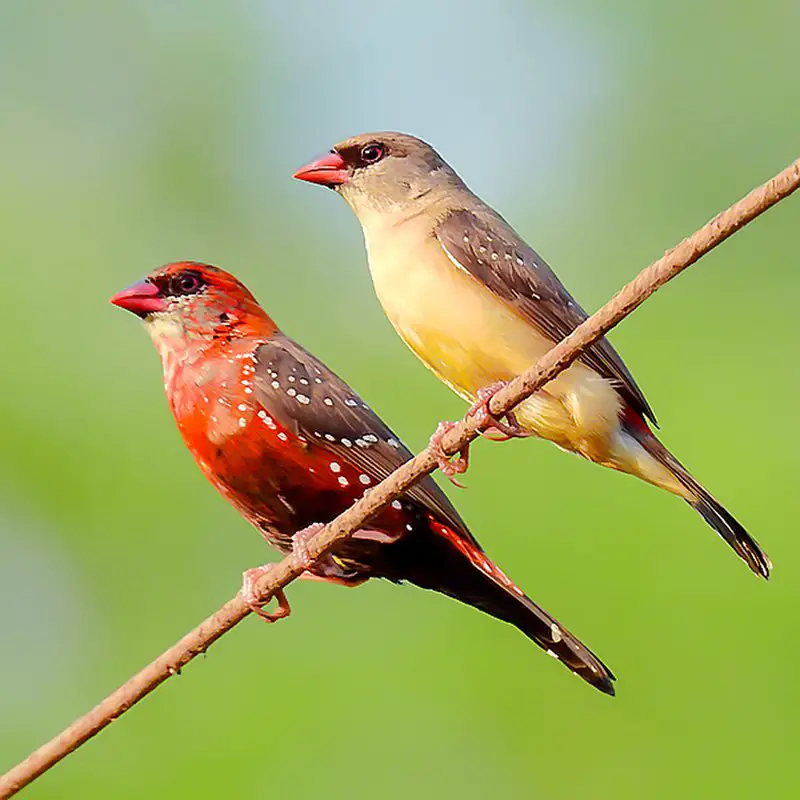
The Red Avadavat bird is a beautiful and popular species of the Estrildidae family. Found in tropical Asia, these birds are known for their vibrant colouring during breeding season – males have bright red plumage which makes them attractive to cage owners.
The species name ‘amandava’ comes from its home range in the Indian Subcontinent where it breeds vigorously during monsoon season.
Although small in size, this sparrow-like breed has an impressive character with a strong will to survive against all odds.
Its melodic chirping adds beauty to nature, creating music that can be enjoyed by anyone who takes time out of their day to appreciate it.Scientific classification:
| Kingdom | Animalia |
| Phylum | Chordata |
| Class | Aves |
| Order | Passeriformes |
| Family | Estrildidae |
| Genus | Amandava |
| Species | A. amandava |
26. Pine Grosbeak
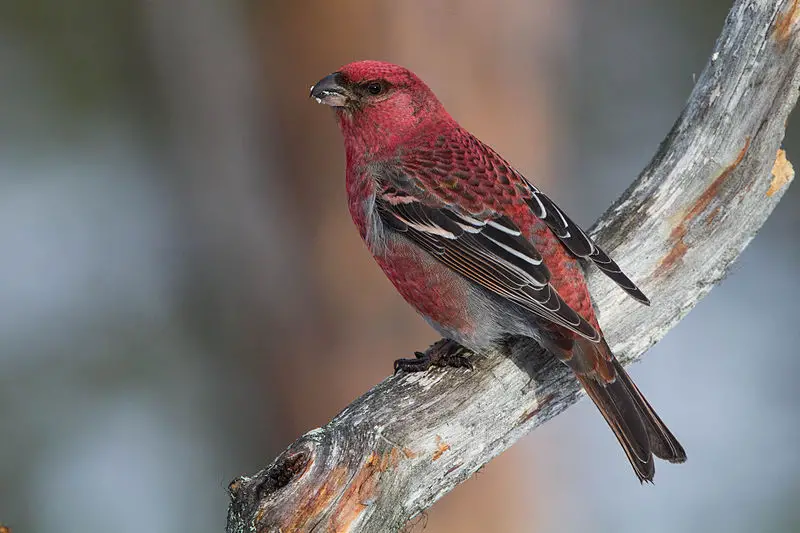
Pine grosbeak is a beautiful bird found across Alaska, western US, Canada and Fennoscandia to Siberia. It belongs to the family of true finch and it is the only species in its genus Pinicola.
This frugivorous bird has bright red feathers on its head and wings with yellowish white underparts that make it very attractive.
During winter season they feed mostly on small fruits like rowans, blueberries etc., while during summer months their diet consists mainly of insects.
They are shy birds but can be seen perched at high branches or singing from the topmost trees if you look carefully enough.Scientific classification:
| Kingdom | Animalia |
| Phylum | Chordata |
| Class | Aves |
| Order | Passeriformes |
| Family | Fringillidae |
| Subfamily | Carduelinae |
| Genus | Pinicola Vieillot, 1808 |
| Species | P. enucleator |
27. Small Ground Finch
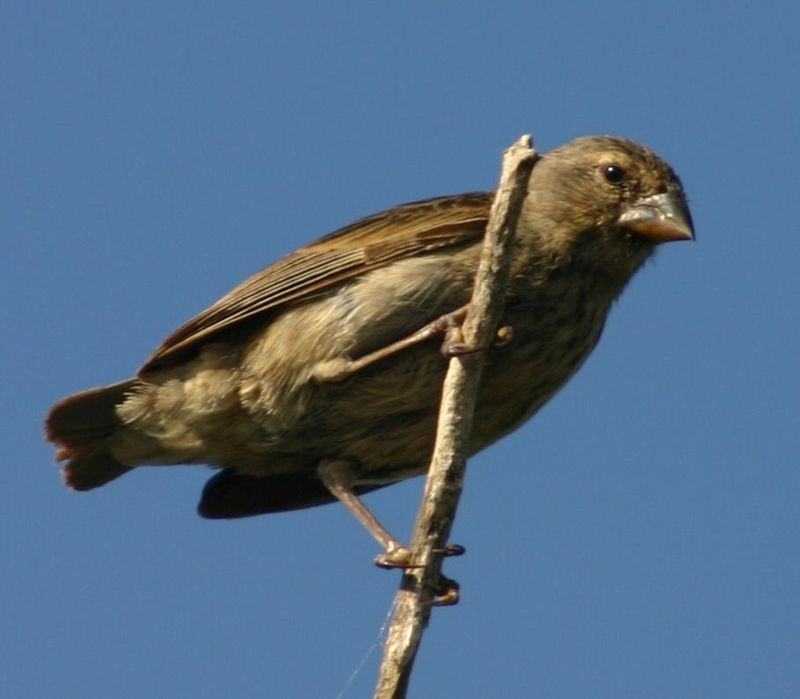
The Small Ground Finch is a species of bird found in the Galápagos Islands. It inhabits shrubland, woodland and other habitats across most islands in the archipelago.
Its diet consists mainly of small seeds as well as parasites that can be found on land and marine iguanas and tortoises.
The finch has been studied extensively by Charles Darwin who noted its role in his Theory of Evolution through Natural Selection due to their various adaptations to different environments within the islands.
This species is listed by IUCN as Least Concern due to its wide range but threats from human activities such as invasive species competition remain an issue for this unique bird’s survival into the future.Scientific classification:
| Kingdom | Animalia |
| Phylum | Chordata |
| Class | Aves |
| Order | Passeriformes |
| Family | Thraupidae |
| Genus | Geospiza |
| Species | G. fuliginosa |
28. Hawfinch
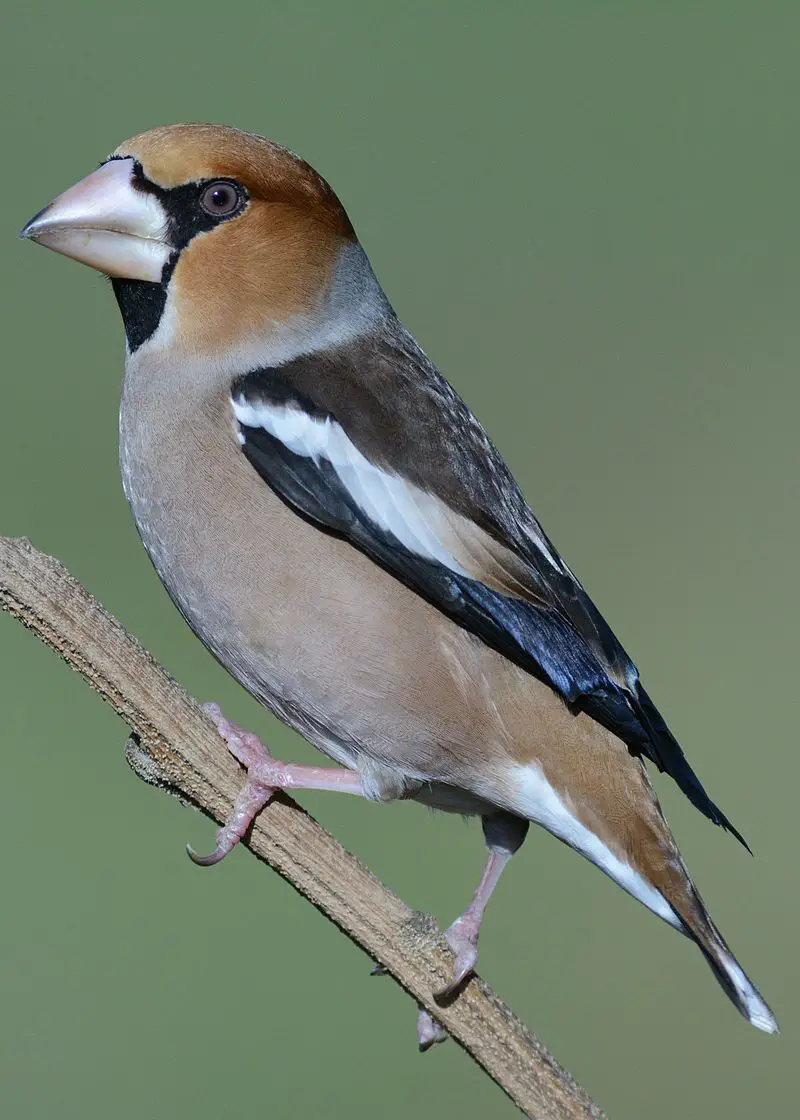
The Hawfinch is a stunning passerine bird of the finch family. It lives in Europe, North Africa, and parts of Asia and stands out for its large size amongst other members of its family.
Its most recognizable feature is its bulky bill which it uses to crack open hard nuts like hazelnuts and cherry stones.
The male has bright pinkish-red underparts while the female’s are more dull browns or greys.
Both sexes also have distinctive black wings with white patches towards their tips. Their closest living relatives are found across East Asia as well as some species in both North America and Canada.
These smart birds often gather together in small flocks during wintertime when food sources become scarce making them much easier to spot.Scientific classification:
| Kingdom | Animalia |
| Phylum | Chordata |
| Class | Aves |
| Order | Passeriformes |
| Family | Fringillidae |
| Subfamily | Carduelinae |
| Genus | Coccothraustes Brisson, 1760 |
| Species | C. coccothraustes |
29. Java Sparrow
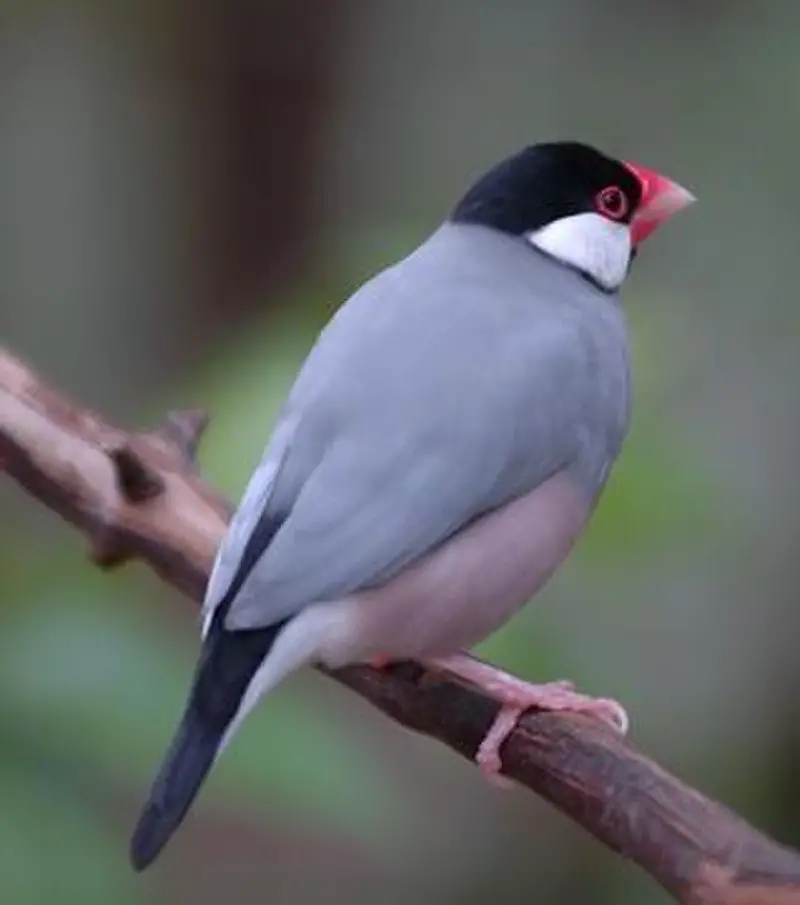
The Java sparrow is a small passerine bird that belongs to the estrildid finch family. It inhabits parts of Indonesia, including Java, Bali and Bawean islands, but has also been introduced in many other countries as a popular cage bird.
Its size can vary from 13–14 cm and it typically weighs around 20 grams. The feathers are brownish with white patches on its wings and tail while males feature black heads with pink or bluish beaks.
They feed mainly on grains like rice, millet or sorghum which explains their nickname “Java Rice Bird”; however they have also developed an appetite for insects when living close to human settlements.Scientific classification:
| Kingdom | Animalia |
| Phylum | Chordata |
| Class | Aves |
| Order | Passeriformes |
| Family | Estrildidae |
| Genus | Padda |
| Species | P. oryzivora |
Also Featured In: Hawaii Big Island Birds You Should Know, Birds that Commonly Found in Bali
30. Yellow-Fronted Canary
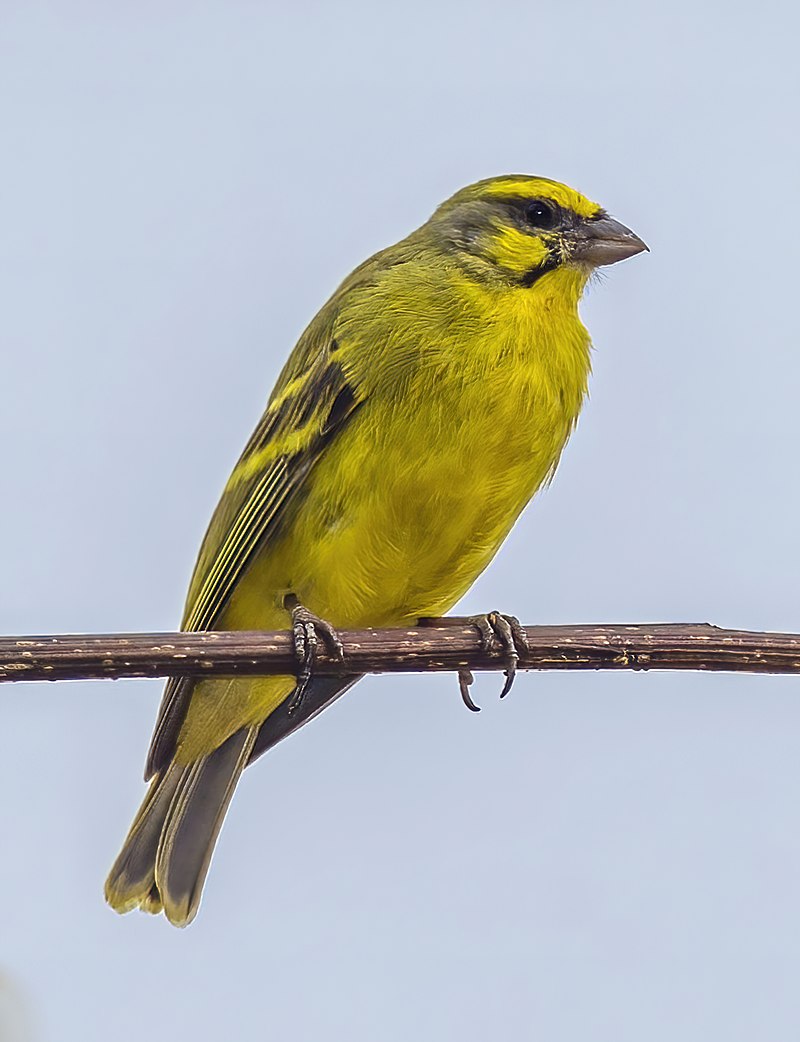
The Yellow-Fronted Canary is a small passerine bird in the finch family, often referred to as “the Green Singing Finch” by aviculturists.
It has bright yellow feathers around its head and face, with greyish-brown wings and tail.
This species was formerly placed within the Serinus genus but analysis of mitochondrial and nuclear DNA sequences revealed this grouping to be polyphyletic; thus it now stands alone in its own genus Crithagra mozambica.
The canary enjoys open woodlands or scrubland habitats where they are able to sing their beautiful songs from dawn until dusk – an activity which also serves as territorial behavior for males during mating season.
In addition, these birds feed on various grains such as grass seeds, buds & shoots of plants or even insects when possible.
With proper care & nutrition these lovely little birds can live up to 8 years making them a delightful pet choice.Scientific classification:
| Kingdom | Animalia |
| Phylum | Chordata |
| Class | Aves |
| Order | Passeriformes |
| Family | Fringillidae |
| Subfamily | Carduelinae |
| Genus | Crithagra |
| Species | C. mozambica |
31. Small Tree Finch
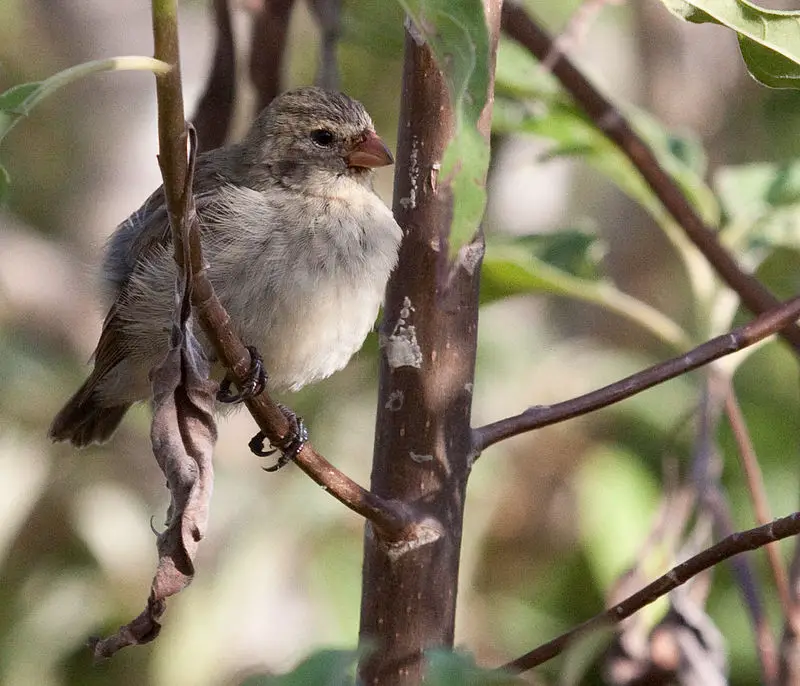
The Small tree finch is a species of bird belonging to the Darwin’s Finch group. It has an impressive beak with curved culmens, and inhabits subtropical or tropical dry forests and shrubland.
During non-breeding season it congregates in large groups with small ground finches. The species is endemic to the Galapagos Islands where they feed on insects, seeds and fruit found near their nests built into bushes or trees across various islands.
They are known for being quite vocal birds that exhibit complex social behavior between family members as well as flock mates when searching for food sources together.
Despite these behaviors, populations have been declining due to habitat loss from introduced animals such as cats & rats who consume eggs along with competition from other avian species among other things like climate change/variation effects affecting water supply levels which can impact availability of food sources.Scientific classification:
| Kingdom | Animalia |
| Phylum | Chordata |
| Class | Aves |
| Order | Passeriformes |
| Family | Thraupidae |
| Genus | Camarhynchus |
| Species | C. parvulus |
32. Brambling
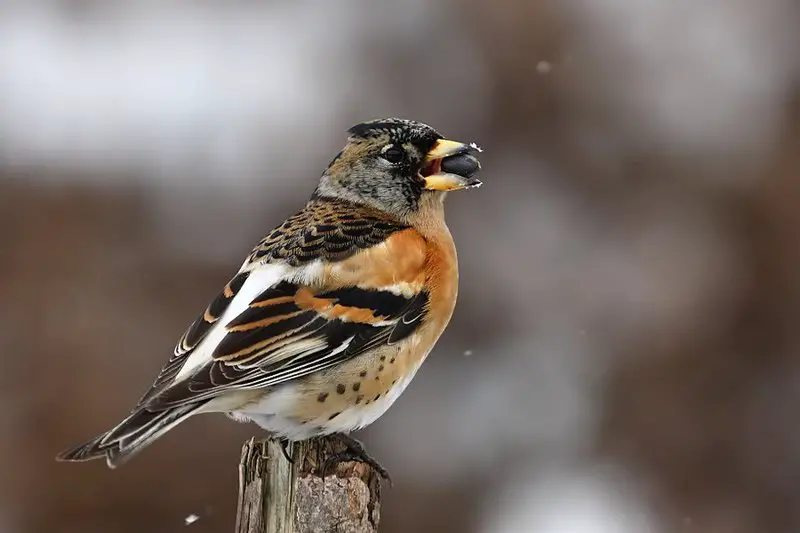
The Brambling is a small passerine bird that belongs to the finch family. It has many names such as ‘Cock o’ The North’, and ‘Mountain Finch’.
This species is widespread in areas, often seen in flocks during its migration periods.
In 1758 Linnaeus included this species under its current scientific name Fringilla montifringilla, which literally translates to “mountain fringe”.
Its feathers are mostly black with white markings on their wings and chest area.
They have short beaks used for cracking open seeds while they feed on insects and berries in summer months; however they primarily eat grains during winter seasons.Scientific classification:
| Kingdom | Animalia |
| Phylum | Chordata |
| Class | Aves |
| Order | Passeriformes |
| Family | Fringillidae |
| Subfamily | Fringillinae |
| Genus | Fringilla |
| Species | F. montifringilla |
33. Lawrence’s Goldfinch
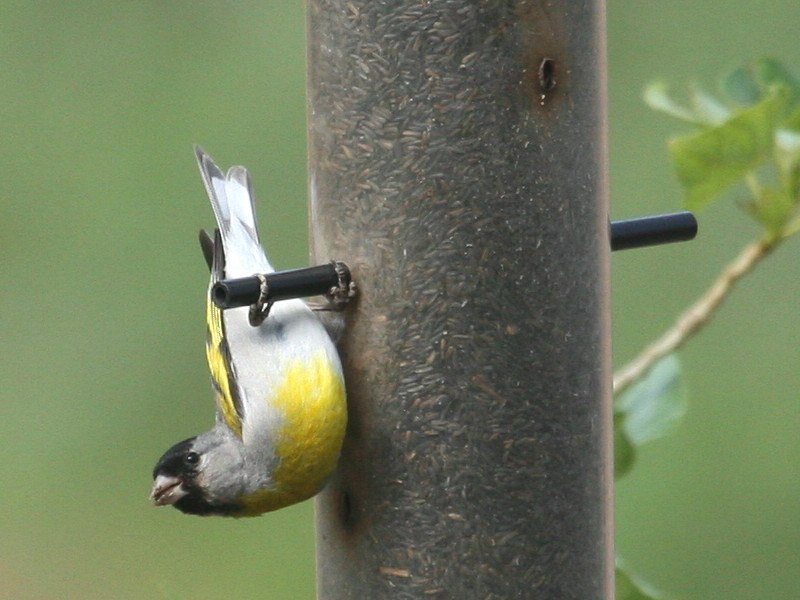
Lawrence’s goldfinch is a small songbird that can be found in California and Baja California, as well as the southwestern United States and northern Mexico.
They measure about 4.75 inches long and weigh 0.4 ounces making them slightly bigger than their lesser cousin but smaller than American Goldfinches with less yellow plumage.
These birds feed on both plants matter such as seeds from grasses or sunflowers which are stored for later use in winter when food sources become scarce however they also eat insects during nesting season to give extra protein to their young chicks.
Their colorful nature makes them popular amongst bird watchers who love to observe these impressive creatures up close while they flit around gardens, parks, meadows or open woodlands singing sweetly along the way.Scientific classification:
| Kingdom | Animalia |
| Phylum | Chordata |
| Class | Aves |
| Order | Passeriformes |
| Family | Fringillidae |
| Subfamily | Carduelinae |
| Genus | Spinus |
| Species | S. lawrencei |
Also Featured In: Yellow New Mexican Birds, Yellow Birds of Arizona
34. Cut-Throat Finch
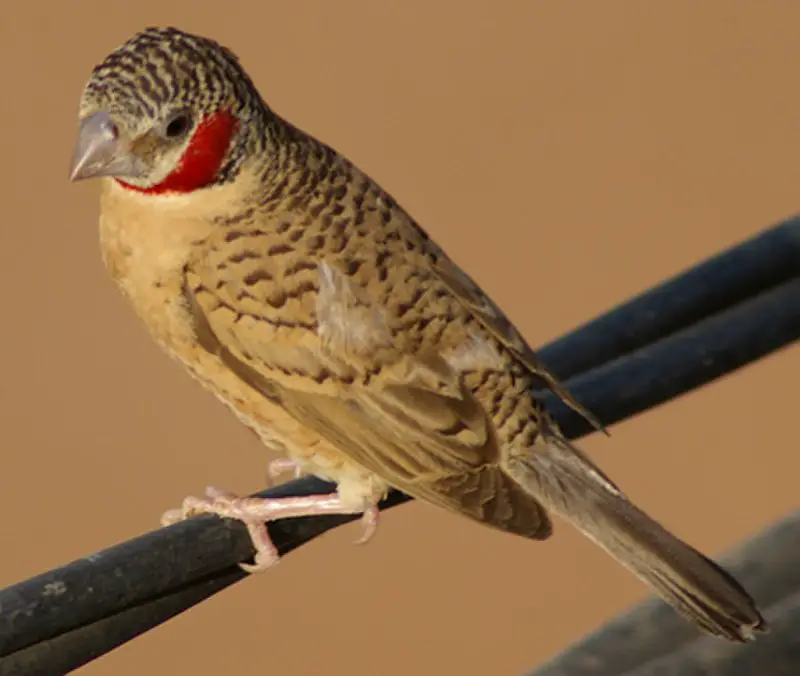
The Cut-throat Finch is a common species of estrildid finch found in Africa. It has pale, sandy brown plumage with flecks of black and a black-brown tail.
This bird also features distinguishing characteristics like its thick white chin and cheeks as well as chestnut brown patch on the belly.
The legs are pinkish or grey while the beak is pointed and yellowish with an orange tinge at the base.
In terms of behavior, it is quite active during daylight hours when they search for food such as small insects, seeds, fruits and nectar from flowers which make up their diet.
They live together in flocks where they sing sweetly to each other when perched on branches or flying around open areas looking for food sources – making them popular amongst birdwatchers.Scientific classification:
| Kingdom | Animalia |
| Phylum | Chordata |
| Class | Aves |
| Order | Passeriformes |
| Family | Estrildidae |
| Genus | Amadina |
| Species | A. fasciata |
35. Double-Barred Finch
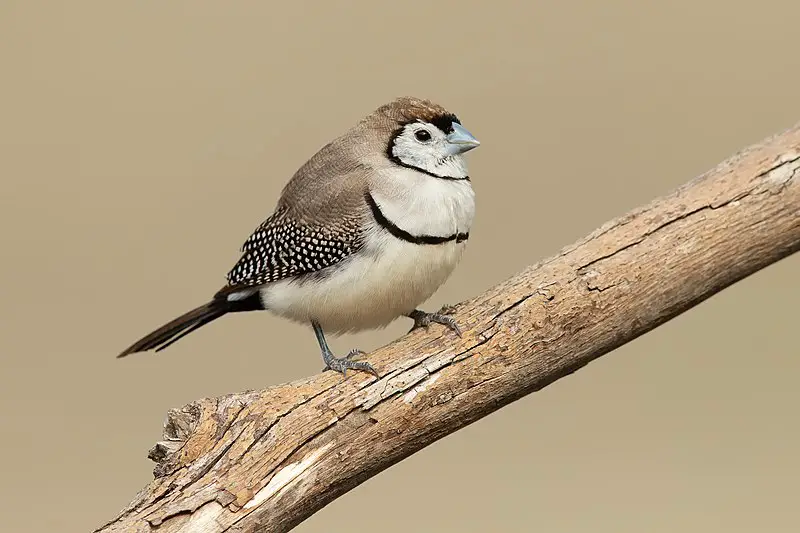
The Double-barred Finch is a species of estrildid finch native to Australia. It inhabits dry savannah, tropical grasslands and shrubland habitats in northern and eastern regions of the country.
The bird has distinctive dark rings around its face that gives it an owl-like appearance; hence one of its common names – Owl Finch.
This small passerine measures up to 12 cm long with a black head, white eyestripes, yellow throat patch and two bars on each wing which give it its name.
These birds are seed eaters but will also feed on insects when breeding season arrives in summer months.
They live in flocks which move from place to place looking for food sources or shelter during extreme weather conditions such as drought or heavy rainsScientific classification:
| Kingdom | Animalia |
| Phylum | Chordata |
| Class | Aves |
| Order | Passeriformes |
| Family | Estrildidae |
| Genus | Stizoptera Oberholser, 1899 |
| Species | S. bichenovii |
36. Sharp-Beaked Ground Finch
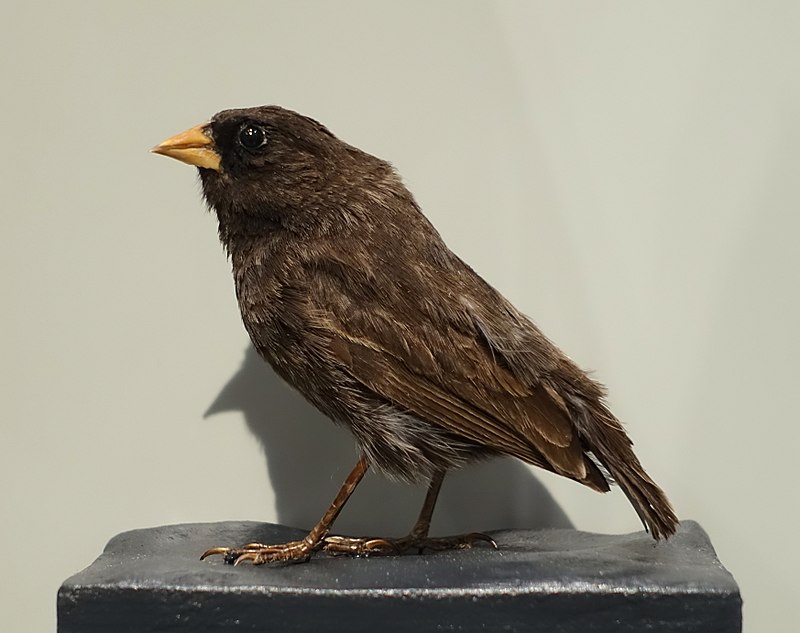
The Sharp-beaked Ground Finch is a species of bird in the Darwin’s finch group, which belongs to the tanager family Thraupidae.
This ground finch is native to Galápagos Islands and has been classified as least concern by IUCN due to its stable population.
It weighs about 20 grams, with males having black plumage while females have streaked brows. The birds feed mainly on seeds but also eat insects occasionally for extra nutrients during breeding season.
They are quite vocal during mating displays when trying to attract potential mates and defend their territories from other competitors.
Although they live off land primarily, these birds do take short flights between islands if food sources become scarce or unsuitable habitats prevent them from settling down permanently in one placeScientific classification:
| Kingdom | Animalia |
| Phylum | Chordata |
| Class | Aves |
| Order | Passeriformes |
| Family | Thraupidae |
| Genus | Geospiza |
| Species | G. difficilis |
37. Eurasian Siskin
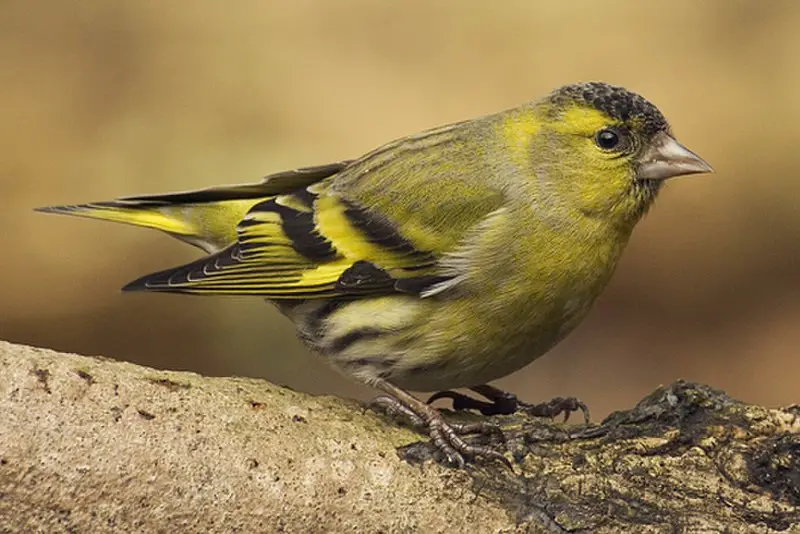
The Eurasian siskin is a small passerine bird of the finch family, commonly known as European Siskin or just Siskin.
It has an archaic name of black-headed goldfinch and lives in forested areas like coniferous or mixed woodland where it feeds on seeds from various trees.
Its plumage is mostly brownish with dark grey wings and tail feathers which have yellow streaks at the edges.
The underside of its body is bright yellow while its head carries a distinctive black cap giving rise to one more common name – ‘black headed goldfinch’.
This species can be spotted across Europe & Eurosiberia all year round making it very common throughout these regions and easy to spot.Scientific classification:
| Kingdom | Animalia |
| Phylum | Chordata |
| Class | Aves |
| Order | Passeriformes |
| Family | Fringillidae |
| Subfamily | Carduelinae |
| Genus | Spinus |
| Species | S. spinus |
38. Diamond Firetail
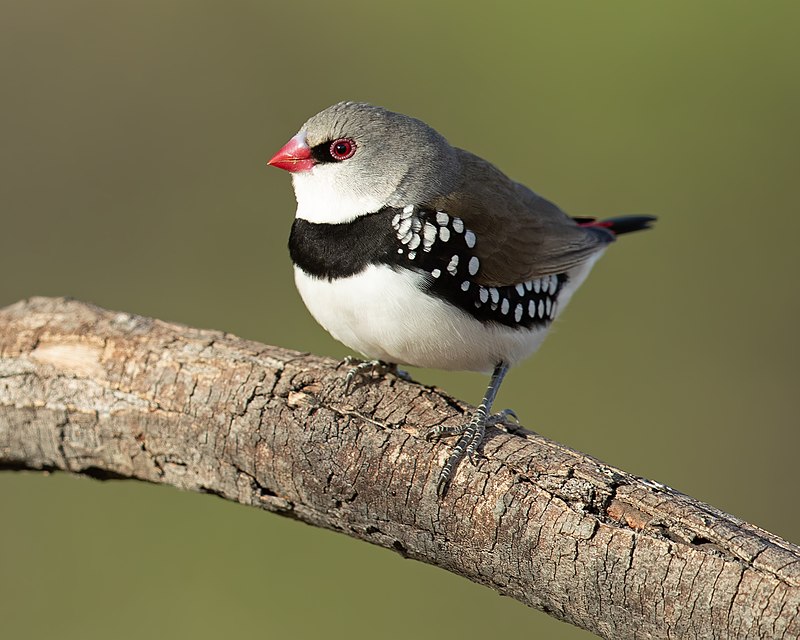
The Diamond Firetail is a species of estrildid finch that is endemic to Australia and can be found in drier forests and grassy woodlands west of the Great Dividing Range from South East Queensland to the Eyre Peninsula in South Australia.
It has bright plumage consisting mainly of black, white, chestnut brown, yellowish-brown with red patches on its wings.
The males have a distinctive bluish-grey patch around their eyes while females are more plain grey or olive green.
Despite being small it’s one of the largest finches in Australia measuring up to 13 cm long and weighing up 15 gms at maturity.
These birds feed primarily on insects but also consume seeds sometimes as well as nectar when available during spring time for breeding season.Scientific classification:
| Kingdom | Animalia |
| Phylum | Chordata |
| Class | Aves |
| Order | Passeriformes |
| Family | Estrildidae |
| Genus | Stagonopleura |
| Species | S. guttata |
Also Featured In: Birds that Live Near Adelaide, New South Wales Birds You Need to See
39. Scaly-Breasted Munia
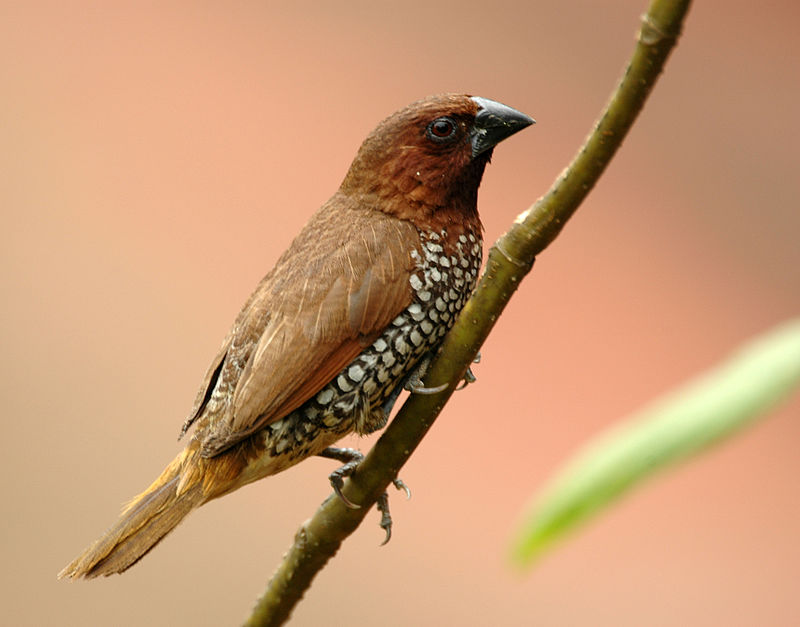
The Scaly-breasted Munia is a small estrildid finch native to tropical Asia. It was formally described and named by Carl Linnaeus in 1758, as its name suggests from the distinct scale-like feather markings on the breast and belly.
The adult bird has brown upperparts, with white lower parts spotted blackish-brown. Its head is pale grey or whitish with an orange beak and legs; the eyes are dark brown.
This species feeds mainly on grass seeds, but also eats insects such as caterpillars in some areas of their range during breeding season.
An interesting fact about this bird is that it builds its nest out of plant stems woven together into a cup shape suspended from trees or shrubs.
Overall they are quite common birds which can often been seen hopping around near human habitation looking for food scraps.Scientific classification:
| Kingdom | Animalia |
| Phylum | Chordata |
| Class | Aves |
| Order | Passeriformes |
| Family | Estrildidae |
| Genus | Lonchura |
| Species | L. punctulata |
40. Woodpecker Finch
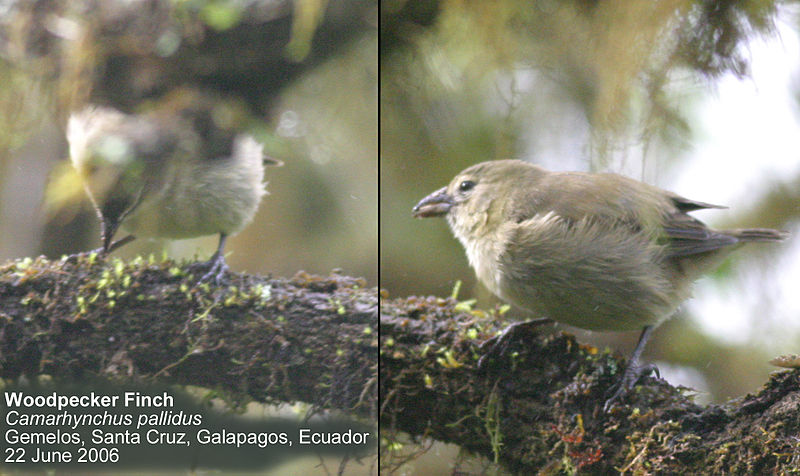
The woodpecker finch is a monomorphic species of bird, found only in the Galapagos Islands. It has adapted to its environment by developing specialized feeding techniques such as probing for insects and seeds with its long beak.
Its diet consists mainly of invertebrates but also includes a variety of seeds which they eat on occasion.
Woodpeckers form bonds between mates during breeding season and build nests together that are lined with feathers or fur from other animals.
These birds play an important role in their ecosystems due to their ability disperse native plant species through seed dispersal, insect control and nest building materials production , making them essential contributors to maintaining healthy natural habitats.Scientific classification:
| Kingdom | Animalia |
| Phylum | Chordata |
| Class | Aves |
| Order | Passeriformes |
| Family | Thraupidae |
| Genus | Camarhynchus |
| Species | C. pallidus |
41. Red-Headed Finch
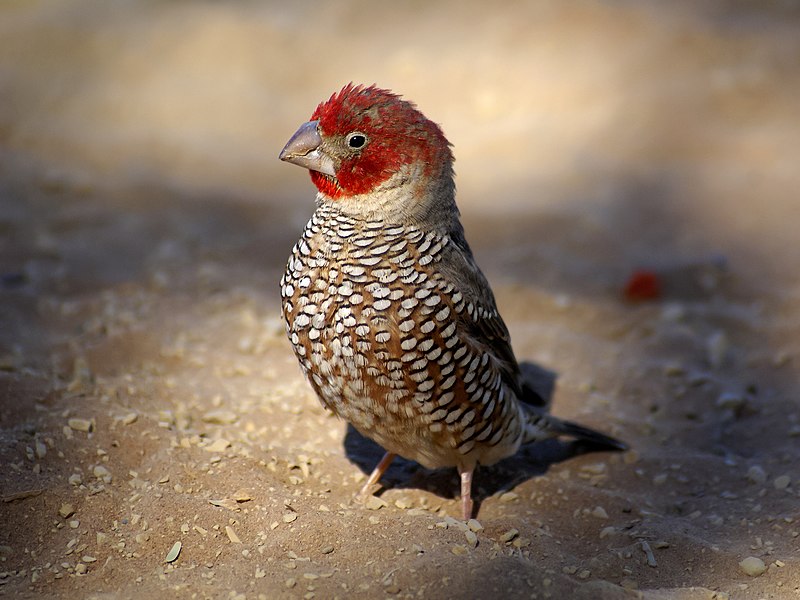
The Red-headed Finch (Amadina erythrocephala) is a colorful bird native to Africa. It has an easily distinguishable bright red head and chest, while the females are less vibrant in color with duller feathers.
This species of estrildid finch can be found across Angola, Botswana, Lesotho, Namibia South Africa and Zimbabwe – it’s estimated global range covers 1.6 million km2.
The males have especially striking features; their resemblance to the Cut-throat Finch is unmistakable due to its unique plumage pattern.
These birds love open woodlands or grasslands where they feed on seeds from plants like maize or millet as well as small insects.
With such beautiful colors combined with wide geographical spread these little birds make for a stunning sight indeed.Scientific classification:
| Kingdom | Animalia |
| Phylum | Chordata |
| Class | Aves |
| Order | Passeriformes |
| Family | Estrildidae |
| Genus | Amadina |
| Species | A. erythrocephala |
42. Arctic Redpoll
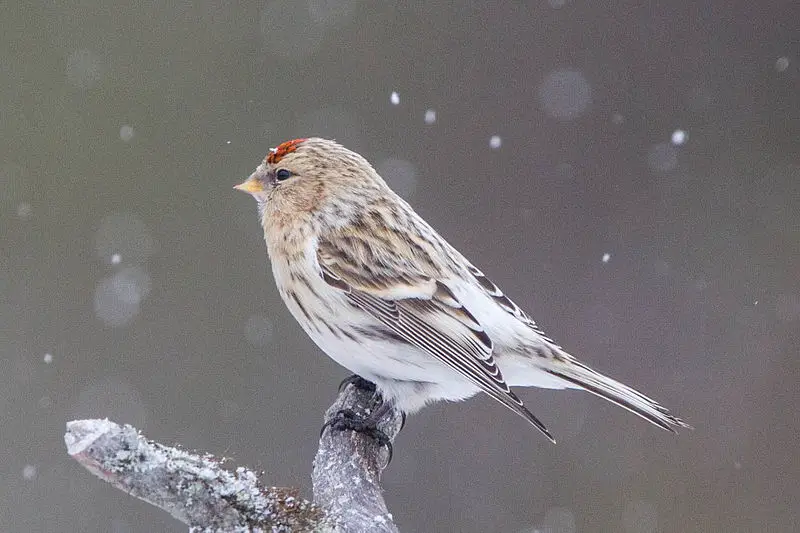
The Arctic redpoll, also known as hoary redpoll, is a species of bird in the finch family.
It breeds mostly in tundra birch forests and has two subspecies- Hornemann’s Arctic Redpoll found primarily in Greenland and neighbouring parts of Canada while Coues’ arctic redpoll can be seen breeding across Northern North America and Palearctic regions.
This small songbird nests on the ground or low shrubs during summer months before migrating south for winter season.
Its main diet consists of seeds but it may occasionally eat insects like caterpillars to supplement its nutrition needs.
These birds have reddish plumage with white patches on their wings which offer them great camouflage against predators such as hawks when they are perched amongst trees or flying over snow covered grounds respectively.Scientific classification:
| Kingdom | Animalia |
| Phylum | Chordata |
| Class | Aves |
| Order | Passeriformes |
| Family | Fringillidae |
| Subfamily | Carduelinae |
| Genus | Acanthis |
| Species | A. hornemanni |
Also Featured In: Birds that Live in Greenland, Tundra Birds
43. Medium Tree Finch
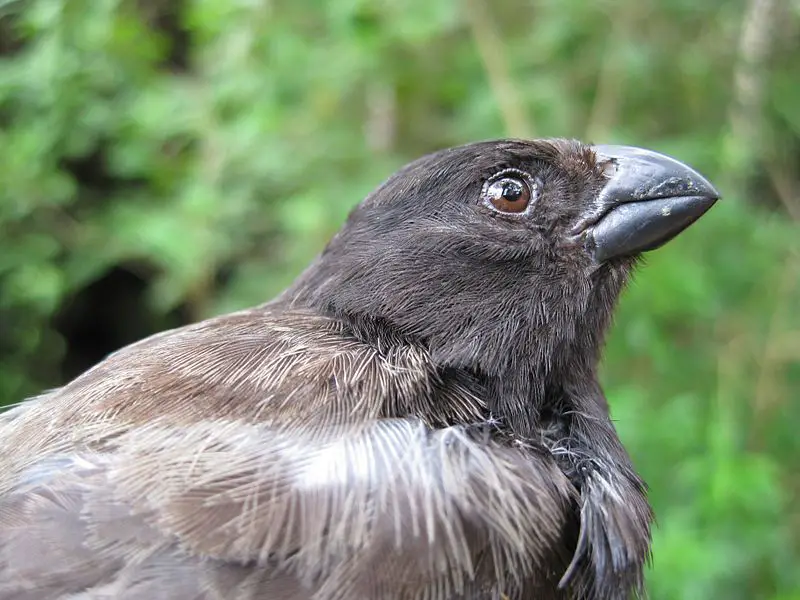
The medium tree finch is a critically endangered species of bird, found only on the Galápagos Islands’ Floreana Island.
It belongs to the Darwin’s finch group of tanager family Thraupidae and has its name derived from an intermediate size beak between that of small tree finch and large tree finch.
With population estimated at just over 100 individuals, it faces extinction due to a combination of introduced predators such as cats, rats, dogs and invasive plant species which have severely reduced its habitat availability.
To prevent further decline in numbers conservation measures are needed such as predator control programs or reforestation efforts by local authorities.
The future survival of this unique avian species depends upon these actions being taken quickly before it becomes extinct forever.Scientific classification:
| Kingdom | Animalia |
| Phylum | Chordata |
| Class | Aves |
| Order | Passeriformes |
| Family | Thraupidae |
| Genus | Camarhynchus |
| Species | C. pauper |
44. Green-Winged Pytilia
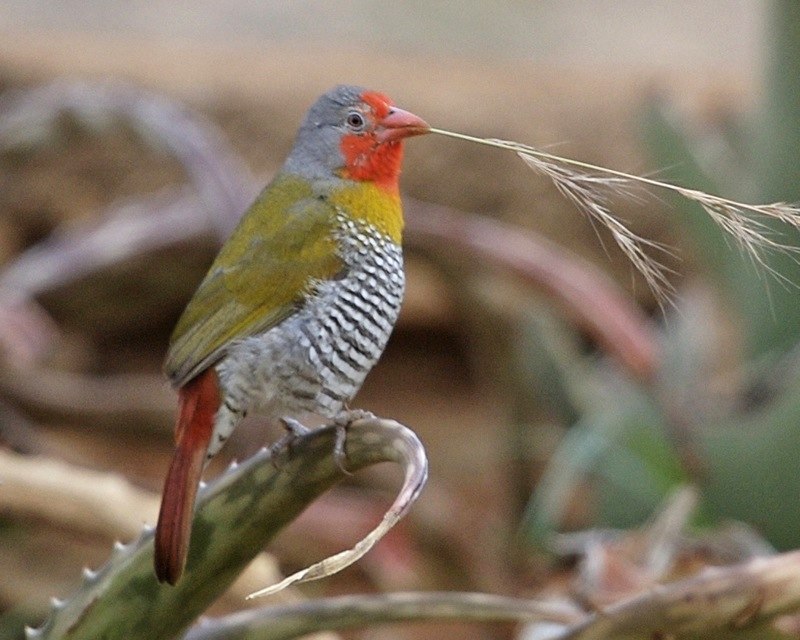
The Green-winged Pytilia is a vibrant little bird belonging to the Estrildidae family. It can be seen in many parts of Sub-Saharan Africa, though it is less frequent in some areas like central, far southern and coastal western regions.
The species was first described by Carl Linnaeus back in 1758 as part of his Systema Naturae publication.
This small seed eater has an olive green head with patches of yellow around its eyes and under its chin; the body feathers are brownish grey with a light blue wash on wings and tail feathers giving them their name – ‘Green-winged’.
They enjoy living near water bodies or open grasslands where they feed mainly on seeds which they glean from plants or capture midair.
With such beautiful colors, these birds make fantastic additions to any garden.Scientific classification:
| Kingdom | Animalia |
| Phylum | Chordata |
| Class | Aves |
| Order | Passeriformes |
| Family | Estrildidae |
| Genus | Pytilia |
| Species | P. melba |
Also Featured In: Birds of KwaZulu-Natal,
45. Black-Throated Finch
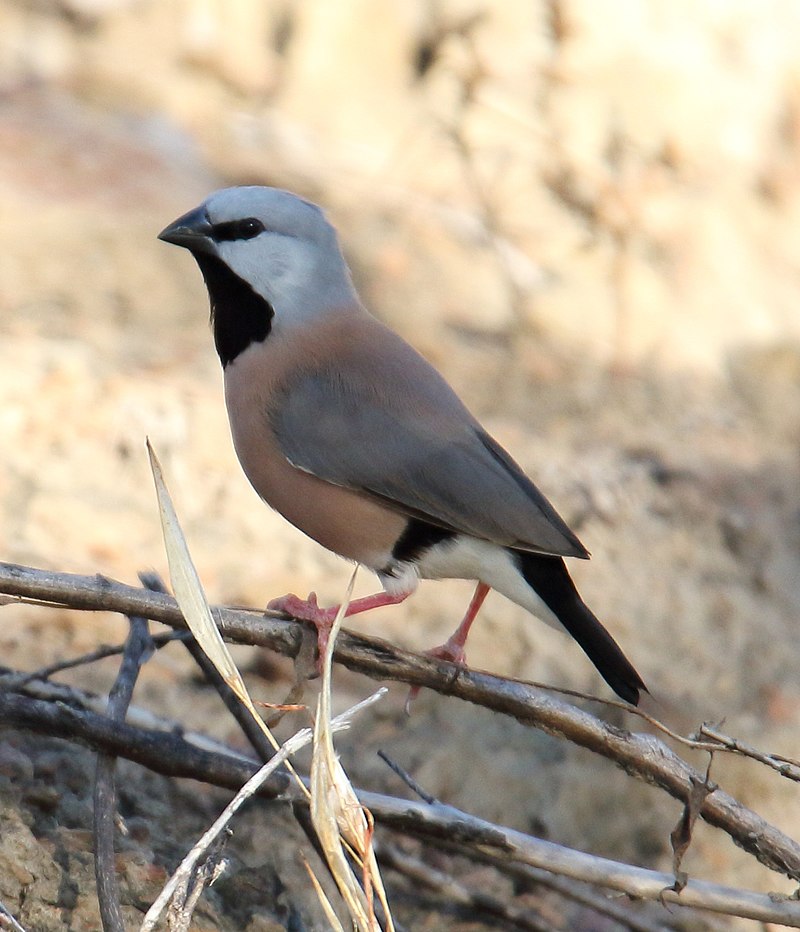
The Black-throated Finch is a species of estrildid finch native to north-east Australia. It has black upperparts, with white spots on its wings and tail feathers.
Its chest is grayish brown and its throat is black with yellow patches around the sides of the neck.
This bird inhabits grassy woodlands from Cape York Peninsula to central Queensland, but unfortunately it’s becoming increasingly endangered due to habitat destruction caused by development – it has already become extinct in New South Wales.
The Black-throated Finch requires dense vegetation for shelter and nesting material, as well as accessible ground cover such as leaf litter or short grasses for feeding purposes.
Conservation efforts are needed in order to protect this species before it becomes too late.Scientific classification:
| Kingdom | Animalia |
| Phylum | Chordata |
| Class | Aves |
| Order | Passeriformes |
| Family | Estrildidae |
| Genus | Poephila |
| Species | P. cincta |
Also Featured In: Jason Islands Birds You Didn’t Know,
46. Atlantic Canary
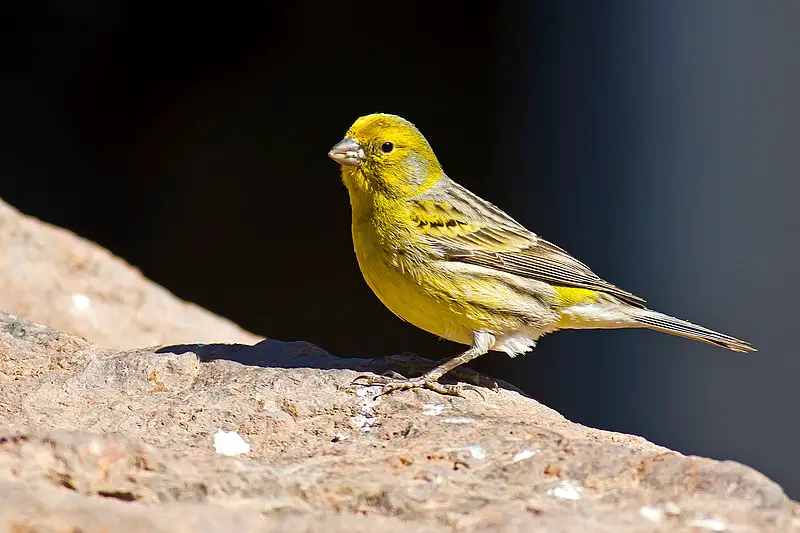
The Atlantic canary is a small, beautiful passerine bird belonging to the finch family. It is native to the Canary Islands, Madeira and Azores islands. Wild birds are mostly yellow-green in colour with brown streaks on their back.
They have a unique vocalization that has made them popular as cage birds all around the world.
In captivity they are fed fruits like apples and grape seeds along with other nuts or grains for nutrition.
These small birds live in flocks among trees where they feed mainly on insects such as spiders and caterpillars which provide protein and energy necessary for survival during winter months when food sources get scarce.
Their ability to adapt quickly makes them an ideal pet choice by many people today.Scientific classification:
| Kingdom | Animalia |
| Phylum | Chordata |
| Class | Aves |
| Order | Passeriformes |
| Family | Fringillidae |
| Subfamily | Carduelinae |
| Genus | Serinus |
| Species | S. canaria |
Also Featured In: Birds of Gran Canaria Island,
47. Grey Warbler-Finch
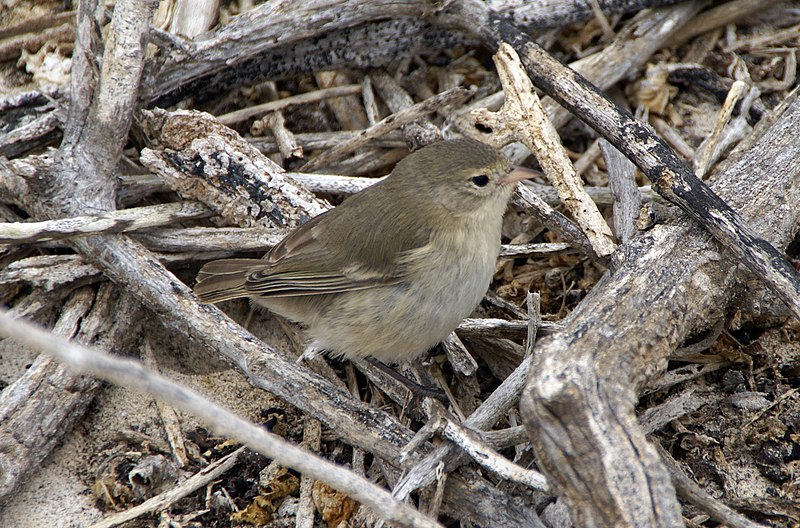
The Grey Warbler-Finch is a species of bird native to the Galápagos Islands in Ecuador. It belongs to the tanager family, Thraupidae, and was formerly considered part of Emberizidae.
This small finch has grey plumage with black bill and legs. Its closest relative is the Green Warbler-Finch which it shares many characteristics with such as habitat preferences and size.
They are found mainly on lower slopes near vegetation or Scalesia forest areas in search for food like insects, larvae, flowers and fruit seeds among others things.
The Grey Warbler Finch uses its sharp beak for cracking open hard shells from fruits or nuts when available during dry seasons where other sources may not be present due too drought conditions throughout their range within this region .Scientific classification:
| Kingdom | Animalia |
| Phylum | Chordata |
| Class | Aves |
| Order | Passeriformes |
| Family | Thraupidae |
| Genus | Certhidea |
| Species | C. fusca |
48. Large Tree Finch
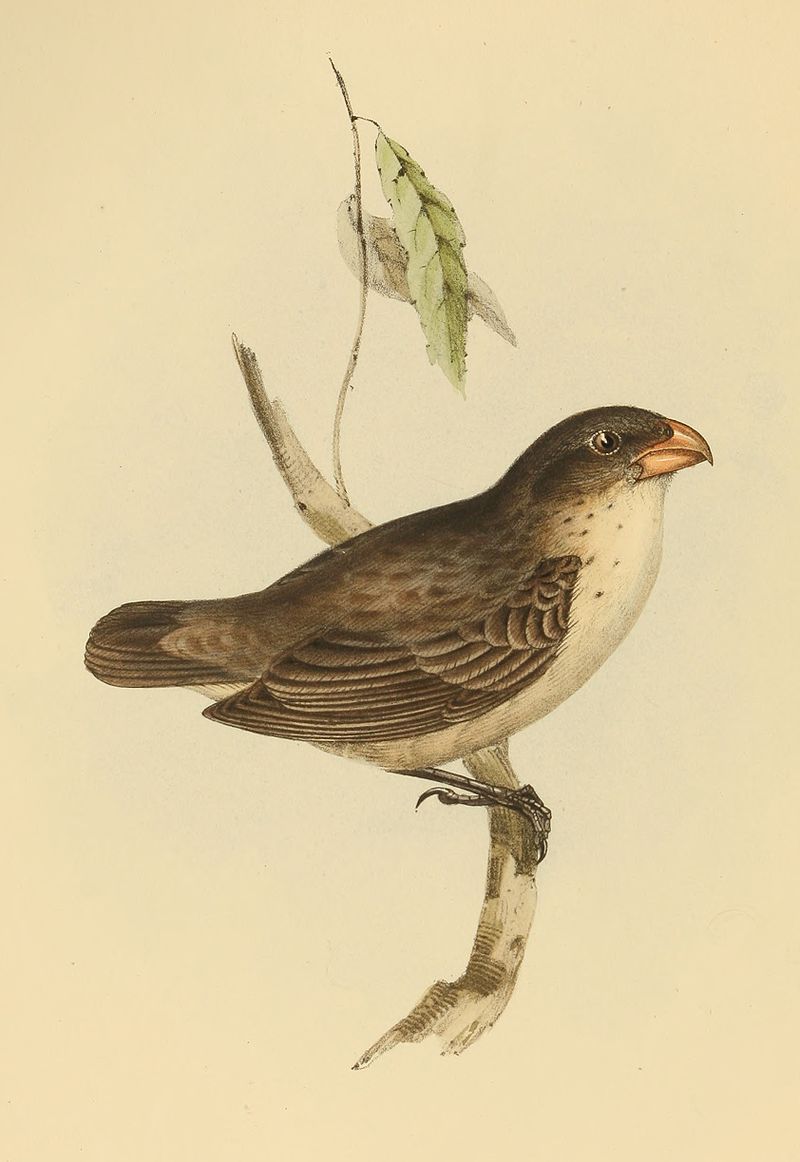
The Large Tree Finch is a species of bird in the Darwin’s finch group, and it is endemic to the Galapagos Islands. These birds are found mainly in subtropical or tropical dry forests, as well as montane forests that stay moist year-round.
They have brown plumage on their backs, with lighter shades for their bellies and white feathers around the eyes and neck area.
The beak of this bird has adapted over time to fit its diet; they use it mostly for eating insects from trees branches but also fruit when available.
This remarkable adaptation helps them survive better than most other birds living there.
Despite being somewhat elusive due to its shy nature, these beautiful creatures can still be spotted if you pay close attention during your next visit to the Galapagos Islands.Scientific classification:
| Kingdom | Animalia |
| Phylum | Chordata |
| Class | Aves |
| Order | Passeriformes |
| Family | Thraupidae |
| Genus | Camarhynchus |
| Species | C. psittacula |
49. Chestnut Munia
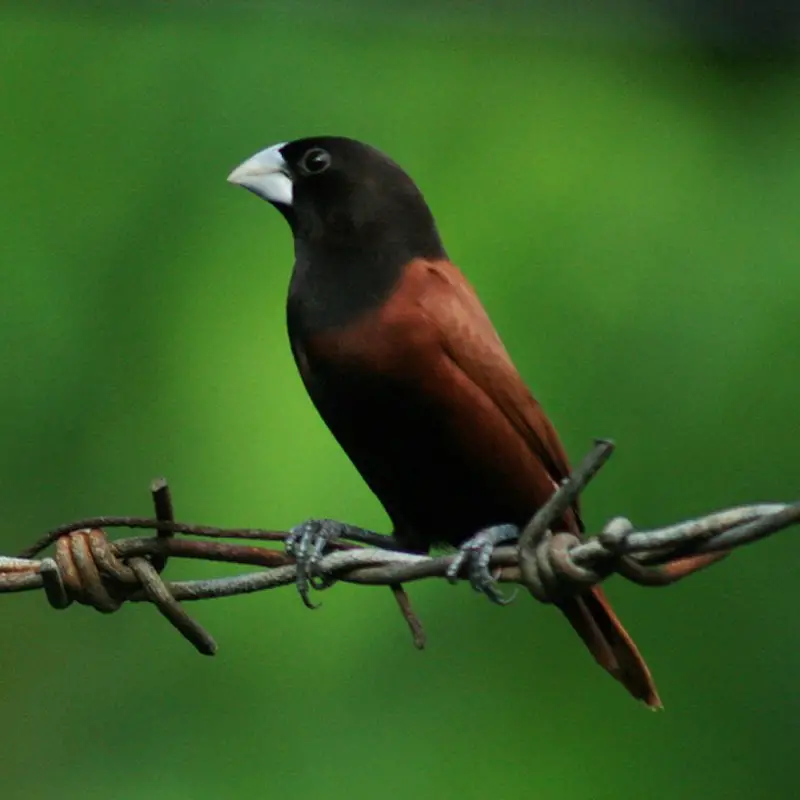
The Chestnut munia is a small passerine bird found in many parts of Asia. It has a glossy black head, chest and wings with white patches along its back and belly.
Its bill is conical shaped while the eyes are dark brown to blackish colored. This species can be seen foraging on grasslands, wet fields or around farmlands where it eats various kinds of grains, insects and sometimes weeds too.
Breeding pairs form during summer season when they construct nests using grasses which are placed near shrubs or trees.
A clutch consists of 2-6 eggs that have greyish-white coloration with blotched markings at times.
The female incubates them for about 11 days before hatching takes place after which both parents feed their young ones until they fledge out from the nest within 16–21 days post hatch date.Scientific classification:
| Kingdom | Animalia |
| Phylum | Chordata |
| Class | Aves |
| Order | Passeriformes |
| Family | Estrildidae |
| Genus | Lonchura |
| Species | L. atricapilla |
50. Mangrove Finch
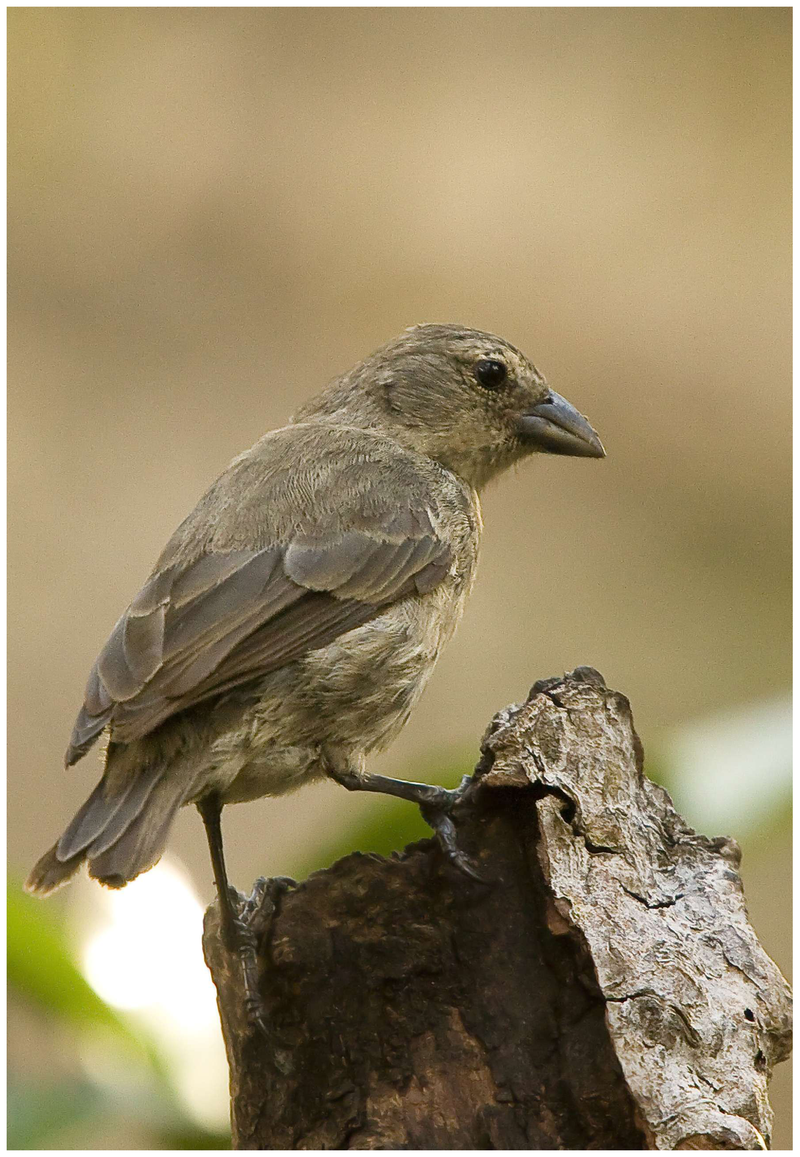
The Mangrove Finch is a species of bird belonging to the Darwin’s finch group from the Thraupidae family, which are endemic in Galápagos Islands.
It was formerly found on Fernandina and Isabela, but recent surveys have failed to detect them on Fernandina.
Unfortunately it has been classified as critically endangered with only an estimated population of 2 due its decreasing habitat caused by human activities such as deforestation for agricultural purposes and grazing livestock.
The destruction of their natural habitats also increases vulnerability towards introduced predators like rats or cats that can hunt these birds easily since they don’t have experience dealing with them yet.
Conservation efforts need to be done soon if we want this unique species survive.Scientific classification:
| Kingdom | Animalia |
| Phylum | Chordata |
| Class | Aves |
| Order | Passeriformes |
| Family | Thraupidae |
| Genus | Camarhynchus |
| Species | C. heliobates |
Also Featured In: Most Common Birds in Isabela Island,
51. Cassia Crossbill
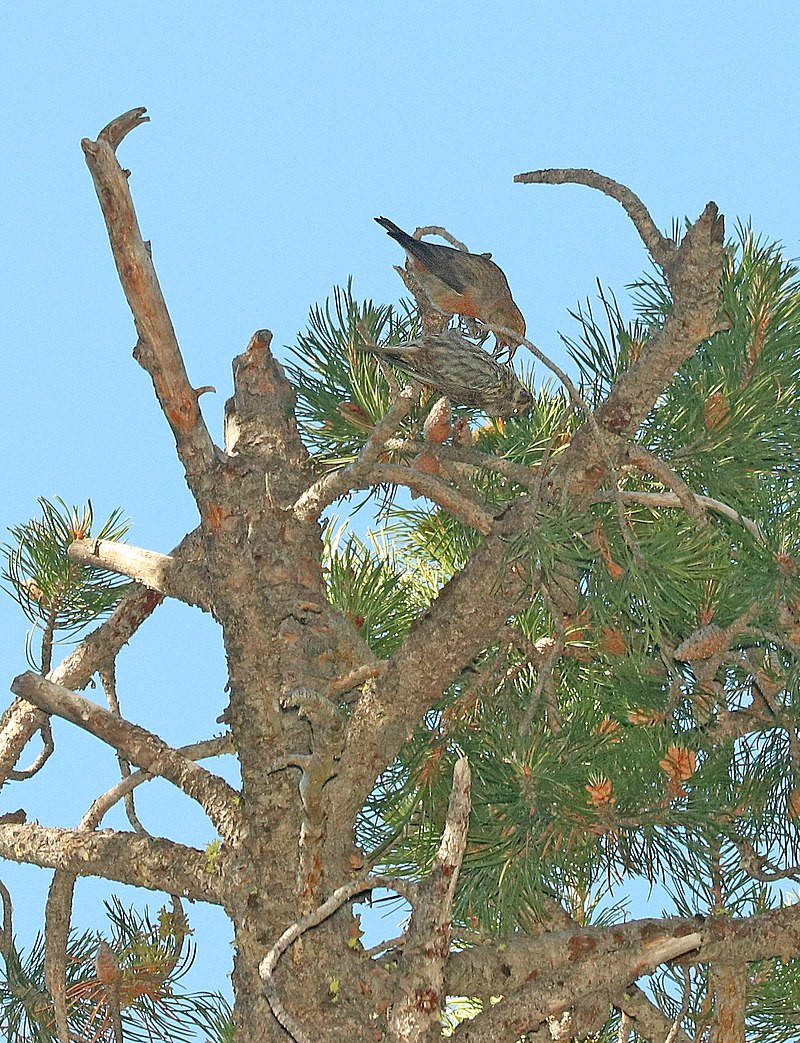
The Cassia Crossbill is a passerine bird native to the South Hills and Albion Mountains in southern Idaho.
It has an impressive beak that is adapted for cracking open pine cones and eating the seeds inside, making it perfectly suited for its habitat.
This species rarely interbreeds with other call types due to ecological speciation, meaning they are distinct from their relatives.
The male of this species boasts beautiful plumage ranging from deep reds through light oranges while both sexes sport white wing bars on either side of black wings which provide camouflage amongst conifers trees.Scientific classification:
| Kingdom | Animalia |
| Phylum | Chordata |
| Class | Aves |
| Order | Passeriformes |
| Family | Fringillidae |
| Subfamily | Carduelinae |
| Genus | Loxia |
| Species | L. sinesciurus |